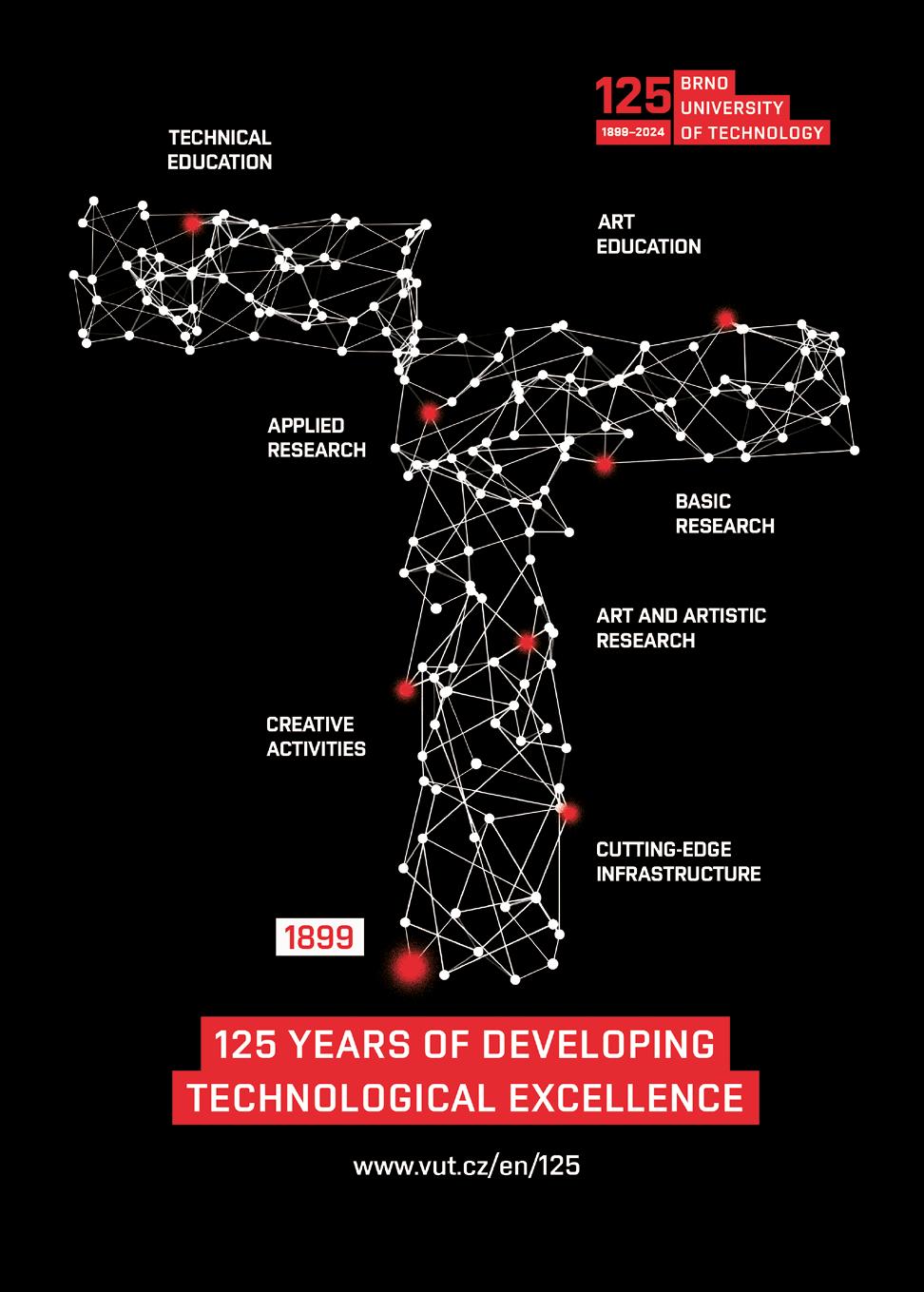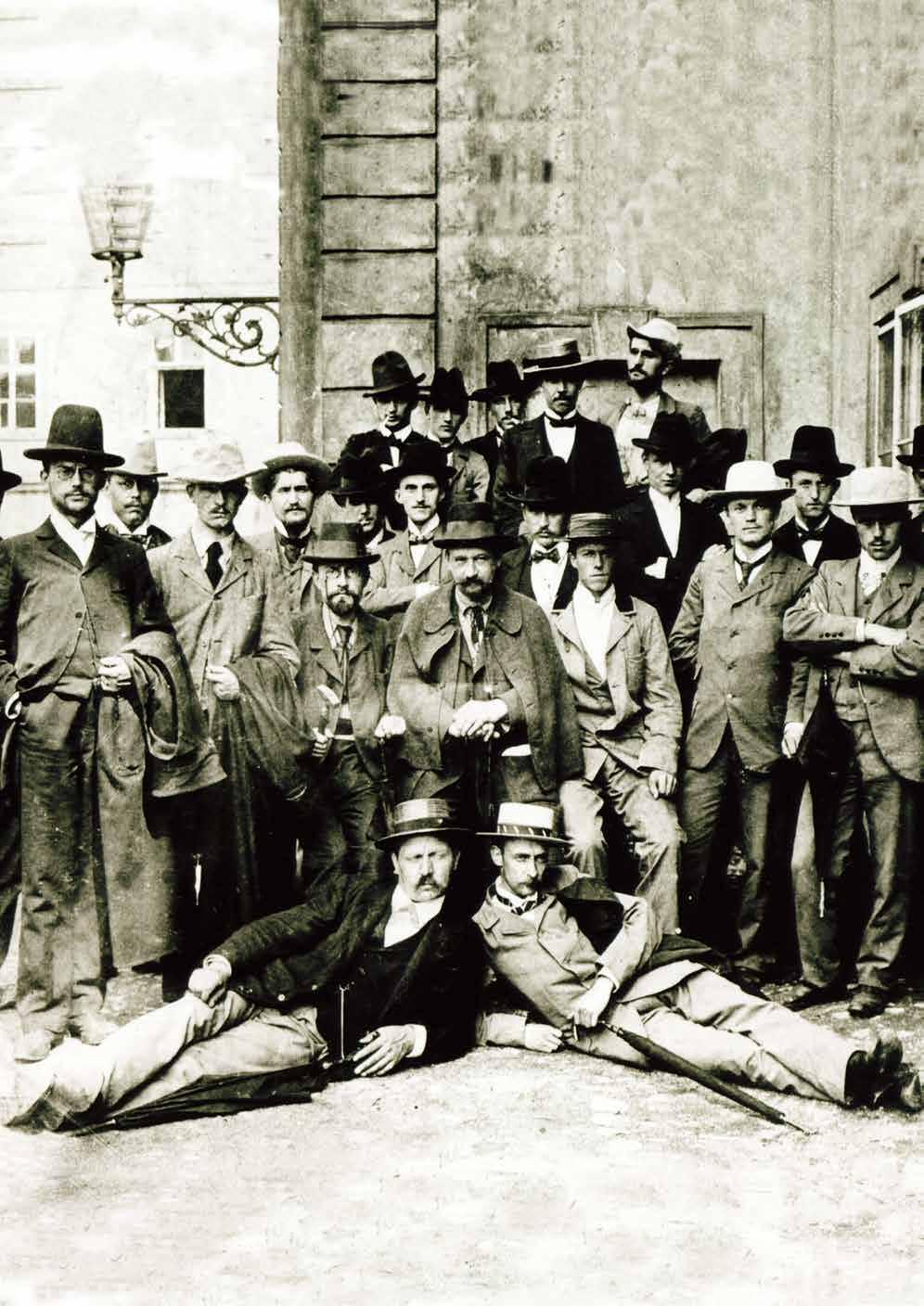
SPECIAL EDITION 2024
125
1899–2024 NEWS
CELEBRATING
YEARS
AT BUT
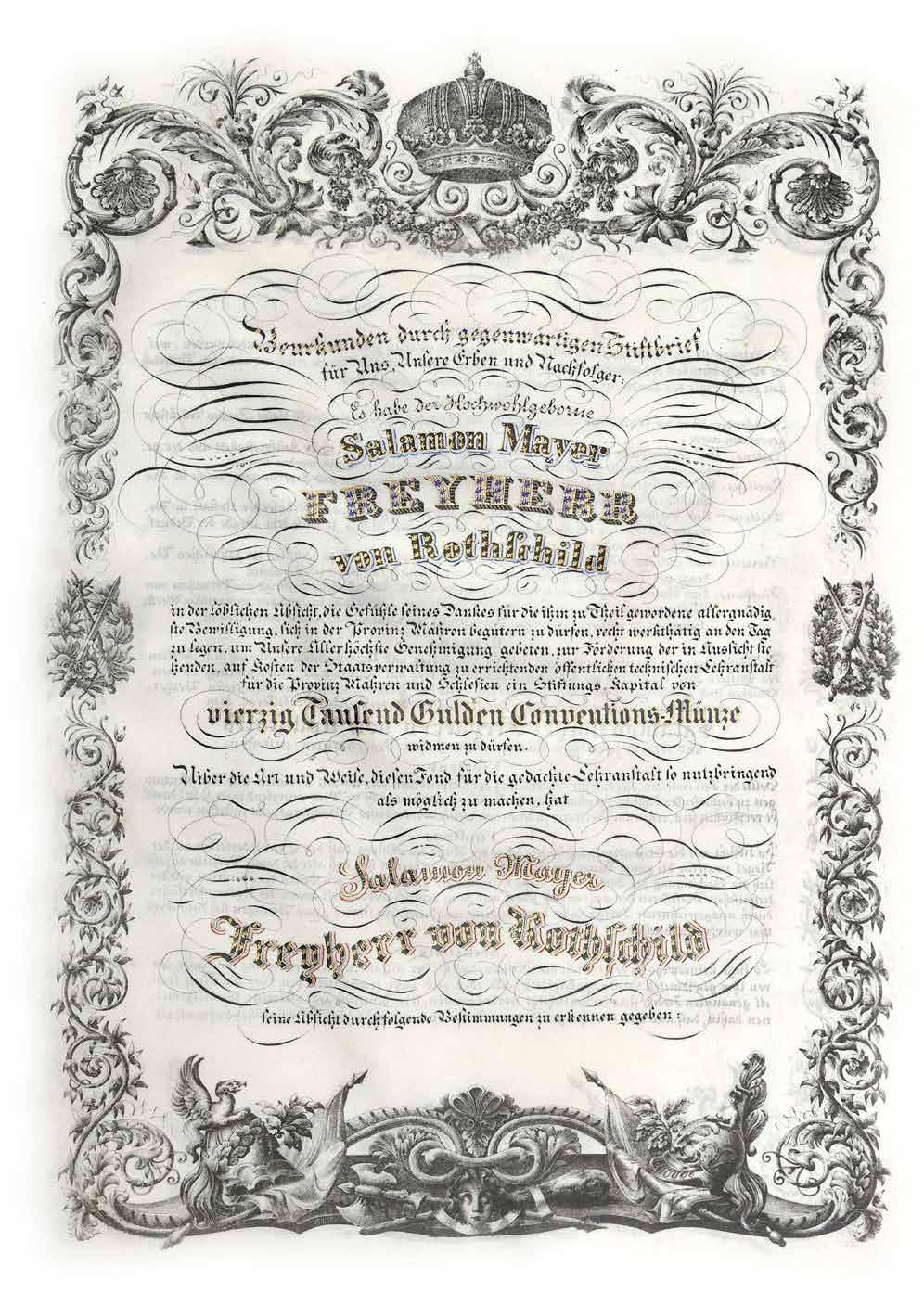
Editor:
Jana Novotná tel.: 541 145 345 janek@vutbr.cz
English translation: Marek Novotný
Editorial Board:
Ladislav Janíček (rector), Miroslav Doupovec (vice-rector), Kamil Gregorek (chancellor), Milan Houser (vice-rector), Jana Kořínková (VUTIUM Press director), Anna Kruljacová (Rector’s Office, Academic Senate of BUT – Chamber of Students), Vítězslav Máša (vice-rector), Daniela Němcová (bursar), Tomáš Opravil (Academic Senate of BUT vice-chairman), Vlasta Sedláková (vice-rector), Iveta Šimberová (vice-rector), Martin Weiter (vice-rector)
CONTENT
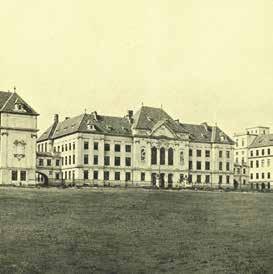
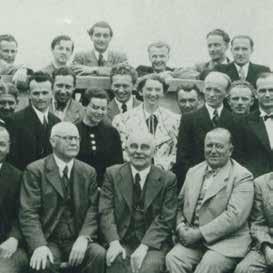
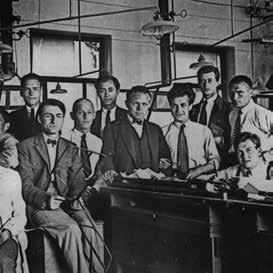
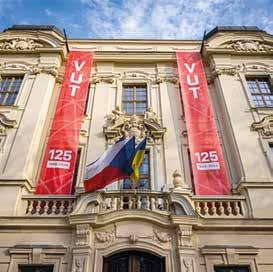
NEWS AT BUT BUT
the Brno University of Technology ID 00216305 VUTIUM Press
E
ISSN
quarterly: published by
Reg. No. MK ČR
7521
1211–4421.
Editorial Office: VUTIUM Press Kolejní 4, 612 00 Brno Czech Republic redakce@vut.cz, www.vutbr.cz Graphic design: VUTIUM Press Typesetting: Jan Janák Printed by: CCB Tiskárna, s. r. o. BUT 125th Anniversary Special Edition Issued on April 22, 2024 NOT FOR SALE! FOREWORD 2 BUT AT A GLANCE 4 Faculties and Institutes of BUT HISTORY 8 The Beginnings of Technical Education in Moravia STUDENTS 11 How History Affected BUT Students’ Lives GLOSSARY 16 BUT from A to Z PERSONALITIES 22 Notable Figures of Brno Technical Universities WOMEN OF BUT 28 History of Women’s Studies at BUT ALUMNI 32 The Promoters of BUT’s Good Name CALENDARIUM 36 Schedule of Events OBSAH
Cover photo: Excursion of BUT‘s second-year students to Barrandien with Prof. Jahn, June 1901 Reverse of the cover: The charter by which Emperor Ferdinand I approved the establishment of the Rothschild Foundation in 1847; the oldest historical document of BUT Source: BUT Archives
Dear Readers,
When one says the Brno University of Technology (BUT), it is interesting to hear who and what comes to one’s mind with the mention of these words. We are celebrating 125 years, one-and-a-quarter century, of our existence. We were established as the first Czech technical university in Moravia on September 19, 1899. We went through a complicated development, which at the beginning was accompanied by the need to define ourselves alongside the existing German Technical University. We went through all the historical upheavals that affected our nation in the 20th century. After the establishment of the independent Czechoslovak state in 1918, the University gained strength and importance: it further supported the development of Czech higher education in Brno, and significantly contributed to the establishment of another Czech university – the Masaryk University. We also had to survive the period of World War II, which was particularly difficult for Czech universities, and the subsequent transformations in the postwar period. After being almost absorbed by the nascent Military Academy in the early 1950s, we finally resumed the full spectrum of technical education and research in the second half of the 1950s.
As a top centre of technical education, we became the successor of the historical traditions of technical education in Brno. Its origins date back to the mid-19th century, when the Brno Czech-German Polytechnic School was established in 1849. It was also the Rothschild Baron family, namely Salomon Mayer von Rothschild, who supported its establishment and, through the foundation he set up, contributed to the development of local higher technical education in the following decades. Situated in the town of Brno, known for its high concentration of industry, the Brno University of Technology (where the famous inventor of water turbines Viktor Kaplan worked) – along with the other technical universities in Prague, Graz, Vienna and Budapest – became an important centre of higher technical education for the whole Austro-Hungarian Empire.
On their journey through history, the presidents of the First Czechoslovak Republic, Tomáš Garrigue Masaryk and Edvard Beneš, connected their names with the University when they received an honorary doctorate here. For some time, the University also bore the name of Mr. Beneš. With the first recipient of an honorary doctorate being Václav Robert, Count of Kaunitz, a prominent supporter of Czech higher education in Brno, honorary doctorates have also been awarded to other leading scientists, engineers, architects and economists, such as Nikola Tesla, Jaroslav Kurzweil, Armin Delong, Eva Jiřičná, Jan Švejnar, as well as the world’s leading entrepreneurs, including Tomáš and Jan Antonín Baťa, Miroslav Sigmund and Sir Frank Lampl. In 1904, Josef Hlávka’s foundation legacy included our University as the only Czech university in Moravia among other supported Czech universities in Prague. We remember with gratitude the personality of Antonín Rezek, who significantly contributed to the promotion of the establishment of the Czech Technical University in
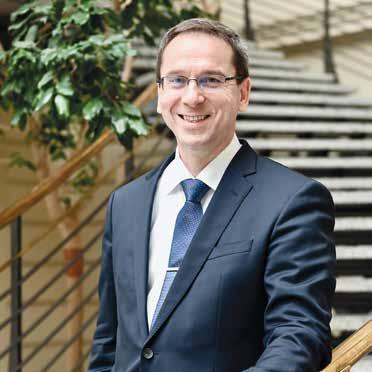
Brno. It is certainly impossible to enumerate the long list of important personalities – professors, scientists, engineers, architects, artists and designers who have connected their professional lives with BUT, but it is impossible not to mention at least some of those who achieved world fame, such as Otto Wichterle, Vladimír List, the already mentioned Armin Delong, Bohuslav Fuchs, Felix Jenewein and Vladimír Preclík.
Today, BUT proudly acknowledges the traditions of technical education in Brno and is fully aware of their mission to provide high-quality technical education at a time when Europe and the Czech Republic are building their competitiveness on the renaissance in technology. The time has come for technology to contribute to the technological and energy self-sufficiency and independence of the European Union. And we are a full-scale technical university: with 18,000 students at eight faculties and three higher education institutes. We are the fourth largest university in the country. Our professional profile covers all fields of technical education. In addition to management, economics and business or forensic engineering, the educational profile of the University is complemented by artistic disciplines focused on fine arts, architecture and design, which give our University an interesting competitive dimension due to the interconnection of technology and art. Having the privilege of institutional accreditation, BUT have autonomy in profiling their study offer. The University has also long been and remains today a respected partner of Czech industry, which is the dominant employer of our graduates.
We are a research university, which is a member of the Czech Association of Research Universities and the CESAER European network of technical and research universities. In terms of revenues, research and education are nominally balanced. We have highly lauded for the balance of our applied and basic research as well. The quality of our results, as far as their impact factor is concerned, is evidenced by the structure of our publications, where 70% are those occupying the first two quartiles and 13% fall into the first decile. The ability to come up with specific technological solutions relevant to current societal needs represents the competitive advantage applied research has brought
2
FOREWORD FOREWORD
us. Its potential at our University is profiled by, among other things, more than twenty national competence centres. The effectiveness of research results is also evidenced by the fact that 10% of our research revenues come from contract research. Today, the University is also connected by more than twenty inter-faculty coordinated areas of interdisciplinary cooperation, which profile the University further. These are semiconductor technologies, nanomaterials and nanotechnologies, cybersecurity, artificial intelligence, digitization and Industry 4.0, photonics and quantum technologies, electron microscopy, space and aerospace technologies, automotive and transportation engineering including e-mobility, environmental engineering and circular economy, environmental energy, hydrogen technologies, nuclear energy, energy storage, but also biomechanics and biomedical engineering, etc.
We are an international university, with 25% of students coming from abroad. We appreciate those 20% who come to us from Slovakia, but we also strive to make our studies attractive to students from other countries, and even though they account only for 5% of the student body, they come from fifty countries from all over the world. Together with nine other European universities, we have become a registered European university. We pay attention to the development of the offer of English study programmes and strive for the active foreign mobility of our students and staff. We are members of the European University Association and periodically undergo international assessment to gain feedback on our position and support for our strategic decision-making. In international rankings, we are among the top 3% of universities in the world, and according to the latest results of the QS World University Rankings we took the 4th position among Czech universities. We have seen a move in the QS rankings by almost 100 places and in the other rankings, THE and ARWU, we have climbed up as much as 200 places year-on-year.
We are a university with an environmental mindset that sees environmental responsibility as a technological opportunity. We are strengthening research and development in the field of environmentally friendly technologies. In internal management, operation, maintenance and construction, we apply nature, climate and environmentally-friendly approaches. We incorporate environmental subjects into study programs, develop new programs, and provide education that strengthens the environmentally responsible thinking of students and employees through internal education.
We are an entrepreneurial university that strives to liberalize the environment for the promotion of entrepreneurship and knowledge transfer. Within our ContriBUTe program, we develop entrepreneurial thinking, understanding knowledge transfer as the logical business interface of a technical university. We are the symbolic owner of the Brno Technology Park, the first in the Czech Republic, which surrounds our campus. We take care of intellectual property (IP) in research and development results, and inspire the establishment of spin-off/start-up companies with the aim of transferring this IP into practice. We support students’ creative efforts and entrepreneurship. In cooperation with the South Moravian Innovation Centre, we share and
connect the infrastructure for business incubation in two technology incubators and also in a creative incubator designed for business development in the field of creative industries, including multimedia and the gaming industry, of which Brno is the centre. We set the conditions for mutually beneficial cooperation with industrial companies, as well as transparent conditions for the management of intellectual property and trade secret protection, including information security certification. We bring innovative models of cooperation in the form of collaborative doctoral studies, so-called industrial doctorates, or follow-up qualification educational programs certified by an internationally transferable micro-certificate.
We are promoting an information-integrated university with a strategic priority, which we build on quality information support for students and employees. We are gradually digitalizing processes, integrating the information environment in support of study agendas, striving to develop information support for project management, computerizing the circulation and approval of documents and documentation, and building a management information system to support decision-making. We pay considerable attention to cyber security and, last but not least, we define and look for the role and effective use of artificial intelligence to support teaching and learning as well as research and development.
Last but not least, we are a university of equal opportunities with a culture that builds on the principles of academic freedom and democracy. We are aware of our duty to represent a pillar of knowledge and values in society, to defend the moral purity and independence of the academic environment, to uphold gender equality, correctness and tolerance, and to create social safety for our students and employees. As recipients of the HR Award, we regard our Academics and researchers, who carry know-how, together with the staff who support them, as our University’s greatest asset. Together with our students and their creativity, we form a unique intellectual community advancing knowledge and producing results that are the source of our University’s competitiveness.
The picture of our University described by these lines certainly cannot cover everything that could be written about it. It will remain only an outline of how far the University has come on its 125-year journey, and where it stands today in the light of current social events. All that has been achieved would not have been possible without the hard, dedicated work of generations of our people across the University. It was generations of employees, students and alumni who shaped the image of our University. A big thank you to everyone for that. Let us hope that our University flourishes in the years to come. That it provides our students with a high-quality and prestigious education and supports them, so that all of them and our graduates can be rightly proud of it. Let us continue to be a good employer for our employees, as well as a quality partner to our industry and a contribution to the whole of society.
Ladislav Janíček Rector of BUT

3
FOREWORD
MILOSLAV
FACULTIES AND INSTITUTES OF BUT
At present, Brno University of Technology consists of eight faculties and three institutes.
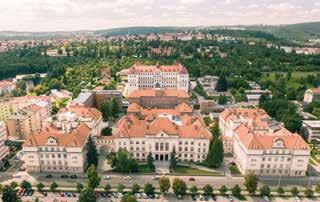
Faculty of Civil Engineering
Faculty of Civil Engineering
The Faculty of Civil Engineering is the largest and oldest faculty of BUT. As early as 1899, the newly established technical school began teaching the first subject, which was civil engineering. An independent Faculty of Civil Engineering was established by merging multiple civil-engineering fields in 1960. Since 1911, the Faculty has been located in a historical building in Veveří Street, where an extensive reconstruction of the whole premises between Veveří and Žižkova Streets was completed in 2013. Since the completion of the building, there has been a meteorological station located on the roof of the Faculty. This station monitors temperature, humidity and atmospheric pressure and offers a beautiful view of the entire campus.
The Faculty consists of 22 institutes and the AdMaS scientific research centre, which has been located in the Pod Palackého vrchem Campus since 2014. In the second half of the 20th century, professors Vojtěch Mencl,
Ferdinand Lederer and Jiří Kratochvíl contributed to the development of the Faculty and its scientific creative work. At the Institute of Geodesy, Viliam Vatrt helped determine the value of W0 , which is globally used to measure altitude.
Students of the Faculty acquire the latest theoretical and practical knowledge that they can apply in their professions. At present, there are 3,494 students registered in all levels and forms of study, including lifelong learning. The promoted trends currently in focus at the Faculty include sustainable construction, circular economy, modern technologies in construction and advanced building materials. Linking the academic community to business in a mutually beneficial way has long been crucial.
Faculty of Mechanical Engineering
A year after its establishment, the new Czech Technical University in Brno opened a second field of study in the form of the Department of Machine Construction, which was renamed the Department of Mechanical Engineering a year later. Thus, the foundations of the Faculty of Mechanical Engineering, located on Gorkého Street, were laid. The first Dean was Michal Ursíny, a professor of structural mechanics.
While in 1951 the communist regime transferred a number of disciplines under the Military Technical Academy
and brought the school almost to extinction, at the end of the 1950s the shortage of technicians and the rapid growth of engineering production required the establishment of an independent Faculty of Mechanical Engineering. This was followed by another key moment of its development when, thanks to the construction of the new Pod Palackého vrchem campus, the Faculty moved to the new premises in 1987.
After the fall of totalitarianism, modernization started and Western teaching standards were introduced. New fields of study have been established at the Faculty, such as industrial design, mechatronics, biomechanics and informatics. This led to a change of its name in 1999 to today’s Faculty of Mechanical Engineering. In 2012, the NETME Centre on the Faculty campus was inaugurated, which helps to bring innovations to engineering. Between 2011 and 2016, a demanding reconstruction of the iconic A1
Faculty of Mechanical Engineering
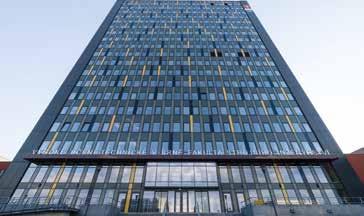
4
BUT AT A GLANCE BUT AT A GLANCE
ZIMMERMANN, IVETA HOVORKOVÁ, ZDEŇKA KOUBOVÁ, ROSTISLAV KORYČÁNEK, MICHAL VESELÝ, VOJTĚCH BARTOŠ, FILIP CENEK, PAVEL ZEMČÍK, KAREL POSPÍŠIL, RADIMÍR VRBA AND PETRA KRÁLOVÁ, HANA LEPKOVÁ / PHOTO ARCHIVES OF FACULTIES AND INSTITUTES
high-rise building, which is now the third tallest building in Brno, took place.
With its 3,500 students, the FME is the largest faculty of mechanical engineering in the country. Its graduates are among the most sought-after on the labour market. The scientists who now work at 13 institutes of the Faculty and at the NETME research centre are also successful.
Faculty of Electrical Engineering and Communication
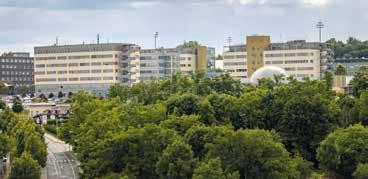
Faculty of Electrical Engineering and Communication
The beginnings of the Faculty date back to 1956, when the Faculty of Power Engineering with the departments of mechanical and electrical engineering was established, which was later in 1959 divided into the Faculty of Mechanical Engineering and the Faculty of Electrical Engineering.
In 1969, the construction of the Pod Palackého vrchem campus, where the Faculty is located today, began. In 1993, the Faculty was reorganized and renamed to the Faculty of Electrical Engineering and Computer Science, which was again in 2002 divided into the current Faculty of Electrical Engineering and Communication and the Faculty of Information Technology.
The Faculty is a dynamically developing institution and with its more than 3,100 students it is one of the largest faculties of BUT. It is involved in national and international projects and contract research projects with practical results, such as monitoring data transmission and data security in backbone networks throughout Europe, the Záchranka application or robots used for the analysis of contaminated areas. It is a founding member of the Czech Battery Cluster and the Czech National Semiconductor Cluster, and cooperates with the National Cyber and Information Security Agency.
The key areas of teaching and research are semiconductor technologies, cybersecurity, nuclear energy, renewable energy, energy storage, electrification of transport, intelligent transport and artificial intelligence, biomedical engineering, plasma technologies, industry 4.0/5.0, and artificial intelligence and machine learning.
Faculty of Architecture
The history of the Faculty of Architecture dates back to 1919, when the Department of Architecture and Civil Engineering was established at the Czech Technical University and the school soon became an important epicentre influencing the domestic avant-garde architectural scene. It continued to build on the functionalist tradition in one of the most important post-war periods, when the Faculty was led by internationally renowned personalities such as Bohuslav Fuchs, Bedřich Rozehnal, Miloš Kopřiva and Vincent Makovský, who, however, had to gradually leave the Faculty as a result of political repression at the end of the 1950s.
Currently, the school has nearly 400 bachelor’s degree programme and approximately 150 master’s degree programme students and 30 doctoral students. The teaching is organized around the studios, which students choose on the basis of their preferred topics and the personalities of the teachers. The studio teaching is followed by theoretical, technical and other expanding subjects enabling graduates to find employment as independent architects, urban planners, employees of architectural and urban planning offices or workers in the academic, cultural or research spheres. Part of the internal setting of the school is openness to social development and international cooperation, which is why there are a number of foreign teachers among its academics. According to the QS Ranking, the Faculty is one of the best schools of architecture in the region of Central and Eastern Europe. It wants to continue to increase its importance by establishing further collaborations, creating new study programs and developing critical thinking.
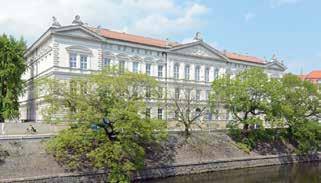
Faculty of Architecture
Faculty of Chemistry
The Faculty of Chemistry has been an integral part of BUT since 1911 with a break between 1951 and 1992. Over the past 30 years, more than 5,000 alumni have passed through the Faculty. Today, the Faculty continues its extraordinarily successful interwar period, when Bohumil Kužma, Jan Albert Novák, Jiří Baborovský, Otakar Kallauner and Cyril Kraus were Faculty members. The quality of the teachers is also evidenced by the fact that as many as eight professors of the Faculty of Chemistry have become rectors of BUT.
Currently, the Faculty focuses on research in the field of the Green Deal, the use of waste from the food industry, agricultural waste and its processing into important raw materials. An example is the patented Hydal biotechnology, which enables the production of a biodegradable polymer polyhydroxyalkanoate from used frying oil. The same area also includes research into the binding of carbon dioxide into silicate compounds with the aim of producing an alternative construction binder with a low carbon footprint and advanced composite materials based on waste raw materials. It is also involved in research in the field of medicinal chemistry, printed electronics, printed sensors and photoactive self-cleaning surfaces. The research is supported by domestic and foreign scientific research projects and cooperation
Faculty of Chemistry
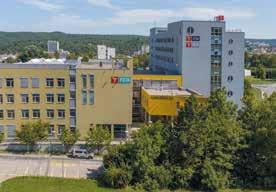
5
BUT AT A GLANCE
with industrial, public and private sector applications.
Students also get involved in projects, especially in follow-up and doctoral study programmes. About 1,100 students are being prepared at the Faculty for work in the chemical, pharmaceutical, food, consumer and construction industries.
Faculty of Business and Management
The Faculty of Business and Management was established in 1992 and the facilities of BUT and its focus on corporate cooperation have earned it a distinctive place among practically oriented faculties of economics. It was one of the first in the Czech Republic to offer a unique opportunity to study and obtain an MBA (Master of Business Administration) degree in cooperation with a foreign university. In addition to educating future
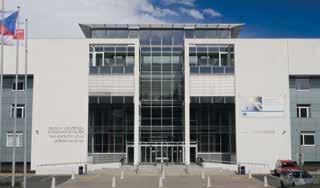
managers and entrepreneurs, the Faculty also focuses on the field of business management and economics, system engineering and informatics. The Bachelor’s degree programme in Accounting and Taxes and the Master’s degree programme in Accounting and Financial Management are certified by the internationally recognised ACCA (Association of Chartered Certified Accountants). In 2018, the new study programme ‘Entrepreneurship and Small Business Development’, conducted in English and focused on small and medium-sized enterprises, was opened. The programme is unique in the Czech Republic thanks to the teaching methods used, which are based on the knowledge of our Finnish colleagues. In cooperation with secondary schools, the faculty has been preparing the nationwide Business Point managerial and marketing competition for seventeen years. In cooperation with companies, practical assignments of various
projects are prepared for students, which are then defended by the competition teams. The activities of the Faculty are also focused on the field of social responsibility. Staff and students plant trees and get involved in social activities. There are currently almost 2,500 students studying here.
Faculty of Fine Arts
With less than 400 students, the Faculty of Fine Arts is the smallest faculty of BUT. At the same time, art has been present at the Technical University since its beginnings in the person of the professor of drawing, the painter Hanuš Schwaiger. The Faculty of Fine Arts has been operating as an independent faculty since 1993, making it the oldest art faculty among non-artistic universities in the Czech Republic, which were established as a desirable counterweight to the educational and cultural centralism of Prague academies.
The combination of an art faculty with a technical university is not common in the world and remains unique in the Czech Republic to this day. With this in mind, the composition of disciplines is also formed: there is a significant representation of disciplines that aim to connect art with technical sciences through the use of the latest technologies.
The Faculty of Fine Arts has seventeen studios. A specific studio is the Visiting Artist’s Studio, where teaching takes place under the guidance of a renowned foreign guest or team. Practical studio teaching is complemented by lectures on art history, design, aesthetics, philosophy, sociology and a number of elective courses. The Faculty of Fine Arts offers not only high-quality university art education at all levels of study, but it is also strongly involved in the field of science and artistic research, and its activities have a significant impact beyond the borders
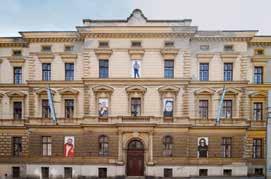
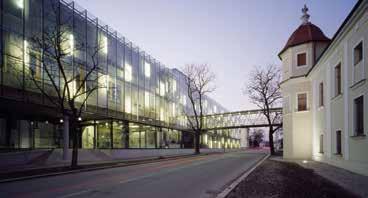
of the Brno region. Together with the Academy of Fine Arts in Prague and the Academy of Arts, Architecture and Design in Prague, it has long been one of the most sought-after educational institutions in the field of art and design in the Czech Republic.
Faculty of Information Technology
The youngest faculty of BUT, which was established in 2002 by separating from the Faculty of Electrical Engineering and Computer Science, currently has around 2,500 future IT specialists. Modern teaching takes place and top research groups work here, focusing on the security and reliability of information technologies, including cyber security and network security, artificial intelligence and machine learning, theoretical computer science, verification and testing, signal, sound and image processing, computer architectures, supercomputing, bioinformatics, as well as quantum technologies and digital systems for chip development. We want to continue this trend in the future.
The Faculty is located on the premises of the former Carthusian monastery in Brno-Královo Pole, which has been reconstructed and supplemented with a number of modern buildings. One of them is a research centre that is part of I4Innovation, a centre of excellence in research in supercomputing, which was established under the leadership of Professor Tomáš Hruška in cooperation with VSB – Technical University of Ostrava. Examples of excellent research include cutting-edge research in speech processing led by Jan Černocký and research in the field of biology-inspired systems and genetic algorithms led by Lukáš Sekanina. Jan Kořenek’s team achieves excellent results in science and commercialization in research into computer network technologies and monitoring of their operation, or research in the
6
BUT AT A GLANCE
Faculty of Business and Management
Faculty of Information Technology
Faculty of Fine Arts
verification of algorithms and systems under the leadership of Tomáš Vojnar.
Institute of Forensic Engineering
In 1965, the Department of Forensic Engineering was established at BUT, which became the Institute of Forensic Engineering in 1970. The aim of the founders was to create a workplace for assessing the causes of accidents on technical equipment and to prepare experts for expert practice in cooperation with BUT faculties.
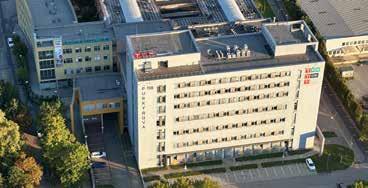
Gradually, the activity expanded to include the investigation of traffic accidents, construction, property valuation and risk management. The Institute of Forensic Engineering is located on the BUT campus on Purkyňova Street. The Institute coordinates three university-wide Master’s programmes: Expert Engineering in Transport, Real Estate Engineering and Risk Management of Technical and Economic Systems, as well as a doctoral programme, which is unique in the Czech Republic, habilitation and professorship in the field of forensic engineering. Prominent personalities, including the first directors of the Institute, Jiří Smrček, the initiator of the Institute’s establishment, and Albert Bradáč, contributed to the Institute’s high reputation before the courts and other public authorities, as well as the professional and lay public. The Institute assists in the development of expert activities by cooperating with the Ministry of Justice of the Czech Republic and by creating expert standards.
Significant achievements of the Institute in the recent past include a very quick and high-quality assessment of the damage caused by the tornado in South Moravia, the identification of the causes of the fall of the cable car to Ještěd, as well as the causes of a number of traffic accidents, many of which were followed by the media. In the future, the Institute
plans to expand its expert fields, both in its own application area and in the field of education.
CEITEC BUT
The Central European Institute of Technology, better known as CEITEC, is a research centre for advanced research, where innovation and research join forces on the way to new discoveries. The Institute was established from the solid foundations of six prestigious Brno universities and scientific institutions. Its headquarters at BUT is the Pod Palackého vrchem campus, where scientists are engaged in theoretical and applied research in the fields of nanotechnology, advanced materials and cybernetics.
CEITEC BUT is proud of its PhD School with an international, interdisciplinary and ever-developing study program Advanced Materials and Nanosciences, where 150 young PhD students can engage in science alongside experienced experts.
On the CEITEC BUT scene, you will also find holders of prestigious ERC grants, who form a top team of researchers. One of them is the young Polish scientist Eric Głowacki, whose revolutionary work consists of research into the neurostimulation of the vagus nerve, which is used to treat chronic inflammatory conditions such as Crohn’s disease. CEITEC BUT is not only a home for its own team, but also opens its doors to the wider scientific community. It also plays a key role in the development of its own research infrastructure, CEITEC Nano, whose scientific staff is active in the world of science and innovation. With its open-access clean rooms, the Institute provides a unique opportunity to offer its state-of-the-art instruments and equipment for use not only by students and employees, but also by other researchers from academia and industry.
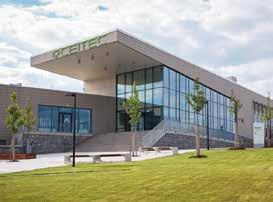
CESA
The Centre of Sports Activities (CESA) is a university-wide workplace for university sports at BUT. The history of university sports dates back to 1904, but it was not until 2001 that it was created by merging the departments of physical education and the administration of sports and physical education facilities CESA, which became a university institute in 2010.
CESA is the co-founder of the Czech Academic Games and has repeatedly organized them, established the tradition of the Day of Sport and expanded it to the Week of Sport at BUT from 2022. Since 2019, it has been the first in the Czech Republic to provide teaching in the Sports Technology study program, where 60 students are studying. It provides all forms of physical education and sports for BUT students and employees.
The semester teaching includes 7,500 excercisers in 84 sports, courses of sports specializations, recreational sports in leisure time, events, educational courses and training, and sports representation of BUT. It addresses the general public through lifelong learning, U3A, suburban camps and professional services. It takes care of the BUT sports complexes, which are some of the largest among universities, with an area of 30,000 m2
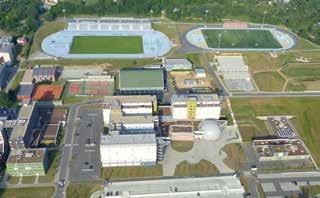
The vision of CESA is the development of the Sports Technology study program, interdisciplinary cooperation with entities in the Czech Republic and abroad, and the completion of the conceptual design of sports so that BUT is an important centre of university sports supporting the physical activity of students and employees and has a successful sports representation and competitive sports infrastructure.
7
BUT AT A GLANCE
Institute of Forensic Engineering
CEITEC BUT
Centre for Sports Activities
THE BEGINNINGS OF TECHNICAL EDUCATION IN MORAVIA
Already in the 18th and 19th centuries, there was an obvious demand for technically educated people needed for industry. With the development of various fields of human activity, such as chemistry, engineering, metallurgy and biology, polytechnic schools were established as both centres of technical education and scientific research.
At the same time, the theory of some technical sciences, such as mechanics, machine building and others, was being developed. In Austria, the Prague and Vienna Polytechnic Institutes were particularly famous, and the Joanneum in Graz, the Technical Academy in Lviv, the Technical Institute in Kraków and the Technical School in Pest also need to be mentioned. Moravia was one of the most industrialized regions of the Austrian monarchy, and Brno, the capital of Moravia, which was the political, economic and cultural centre of Moravia, also attracted foreign entrepreneurs with its rise caused by the Industrial Revolution. The main industries included the production of wool and wool cloth as well as mechanical engineering. The first wave of foreign entrepreneurs coming from the German lands at the end of the 18th century was followed by a second wave, triggered by the gradual emancipation of Jewish merchants on the basis of the provisions of the Patent of Toleration for Moravia in 1782.
The need to establish a technical school in Brno was thus urgently felt from the 1840s at the latest and was related to the extraordinary
KAREL MARÁZ / PHOTO BUT ARCHIVES
industrial development of Brno, which is sometimes referred to as Moravian Manchester. Efforts to establish a polytechnic institute in Brno began to take shape in 1847. On November 28, 1847 the Austrian Emperor Ferdinand I approved the establishment of a technical school and by a document dated December 27, 1847 granted Salomon Mayer Rothschild permission to establish a financial foundation to support the future public technical school for Moravia and Silesia. Rothschild established the Foundation as an expression of his gratitude for the imperial permission, which – despite his Jewish origin – allowed him to purchase land in Moravia for his business. Discriminatory barriers against Jewish entrepreneurs did not fall until 1849 and 1860, respectively, when they were allowed to freely buy land and houses and to settle freely in cities.
However, the main financing of the school’s existence was taken over by the Moravian estates. On January 24, 1849 the Moravian Provincial Assembly adopted a resolution on the establishment of a technical school called k. k. Technische Lehranstalt –i.e. imperial and royal technical school.
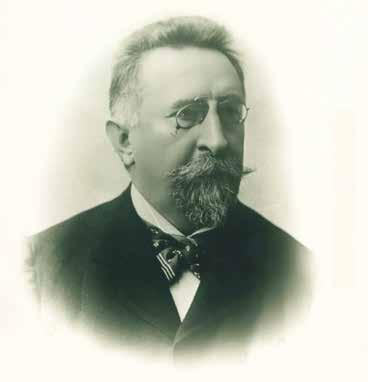
It was conceived as a German-Czech educational institute and its organizational structure was approved by the Emperor on September 13, 1849. On December 29, 1849, the first teachers were appointed, and on January 14, 1850, the school was inaugurated. However, the school was struggling with a lack of money. The poor financial situation led to a number of students and the best teachers leaving for Vienna and Prague.
8
HISTORY HISTORY
The first rector of the university, Karel Zahradník
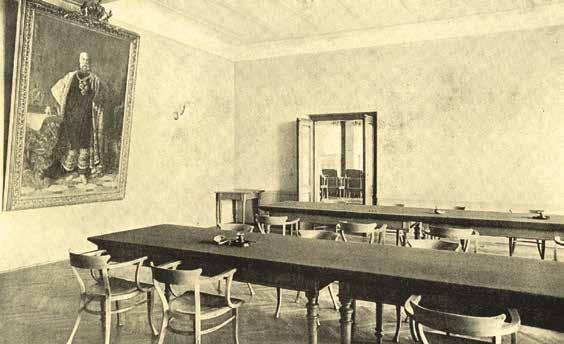
On July 8, 1867, the Austrian Emperor approved a new organizational statute for the school and a change of name to a technical institute. On May 4, 1873, the Technical Institute was declared a university by the Act of the Imperial Council No. 92 and its new name became the German Technical University in Brno. Students were now explicitly required to have knowledge of German, and the Czech language was no longer to be the language of teaching. Use of the Czech language had not been overly supported by the school management and it did not find much interest among students either. It turned out that teaching in German was often preferred by Czech students as well, as it provided them with better opportunities for career development. This led to the transformation of the school into the German Technical University in Brno, which was not abolished until the autumn of 1945.
Efforts to establish the Czech Technical University in Brno and their realization
However, the situation in society was changing drastically starting from the 1890s. Increasingly tense nationalist clashes between German and Czech-speaking inhabitants and the politicization of the Czech language and educational requirements from the 1890s onwards led the Czech-speaking inhabitants of Moravia and Brno to increasingly obvious efforts to establish an independent Czech technical institute and university. These efforts culminated on September 19, 1899 in the signing of the imperial decree on the establishment of the new
technical university which was initially called the Imperial and Royal Czech Technical University in Brno. At the same time, the first four professors were appointed. Two Czech members of the Viennese government, Antonín Rezek (1853–1909), professor of history at the then Charles-Ferdinand University in Prague, and the section head of the Ministry of Education and Culture, and Minister of Finance Josef Kaizl (1854–1901), professor at the Faculty of Law at the same university, played a significant role in the founding of the school. On October 7, 1899, Karel Zahradník, a senior professor, became the first rector of the school which started with fewer than fifty students. The process of establishing the Czech Technical University in Brno took place between 1900–1919 with the foundation of individual departments and was completed in 1919. From 1918 the school was called the
Czech Technical University in Brno, which was changed at the beginning of March 1937 to the Dr. E. Beneš University of Technology in Brno; on March 16, 1937, President Beneš received an honorary doctorate in technical sciences here.
The turbulent times of the late 1930s and 1950s and the school in the years 1960–1989
Due to political developments, the inscriptions with Beneš’s name were removed from the technical buildings under somewhat dramatic circumstances on the night of November 23 to 24, 1938. Like all Czech universities, the Czech Technical University in Brno stayed closed from November 17, 1939 during the Nazi occupation until liberation in 1945. The German Technical University in Brno continued its activities even during the occupation and was abolished on October 18, 1945 by Presidential Decree No. 123. Its institutes, facilities and all its property fell to hands of the Czech Technical University in Brno, which returned to its name of 1937 with the name of the President of the Republic. This means that to a certain extent, today’s BUT is also the successor of the German Technical University in Brno.
Especially as a result of the Communist coup in February 1948, turbulent development full of changes continued. By the Order of the President of the Republic on the Organization of Military Universities of August 15, 1951, the Military Technical Academy was established in Brno. The basis of
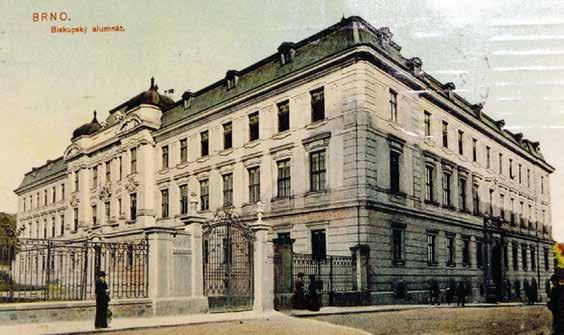
9
HISTORY
Staffroom of the Czech Technical University in Brno
The former Brno Episcopal Seminary, today the seat of the BUT Rector’s Office
this university was the material equipment, buildings and teaching staff of the Dr. E. Beneš University of Technology in Brno, which was abolished by the Government Decree No. 80 on organizational changes at universities on October 2, 1951. At the same time, a University of Civil Engineering was established in Brno with the Faculty of Civil Engineering and the Faculty of Architecture and Building Construction, to which the Department of Foundry Engineering was attached. These “experiments” were put to an end by Government Decree No. 38 of July 24, 1956, by establishment of today’s Brno University of Technology. As in the whole country, the period between 1960s and the 1980s was affected by the political and social events of the time. However, we cannot forget the significant expansion of the BUT campus with a new area under Palacký Hill. The lack of space for teaching, research and accommodation capacity of BUT was to be solved first by building a new campus in the originally planned area at the foot of Kraví hora, referred to as Academic Square. In 1961, however, it was decided to locate the campus on the eastern slope below Palacký Hill between Královo Pole and Žabovřesky. Construction began with the building of dormitories in the second half of 1967.
A period of new development and opportunities
It was not until the events of November 1989 that the impulse for the new development of the school became, as a result of which, among other things,
new faculties were established. On May 23, 1991, an agreement was signed between the Rector of BUT, the Rector of the Military Academy in Brno and the Mayor of the City of Brno on the return of the historical premises of the buildings on Veveří Street to the ownership of BUT. The Faculty of Business and Management was established by the Rector’s Decision No. 67 of September 15, 1992, the Faculty of Chemistry was established by the Rector’s Decision No. 68 of November 3, 1992, and the Faculty of Fine Arts was established by the Rector’s Decision No. 73 of December 31, 1992. In 1996, VUTIUM Press was established, which has gained the position of one of the largest and most prestigious publishers of professional literature in the Czech Republic. The Faculty of Technology and the Faculty of Management and Economics in Zlín were also detached from BUT. On January 1, 2001, they became the independent Tomas Bata University in Zlín.
BUT is currently one of the most successful and award-winning universities. The University manages not only to collect achievements and awards, but also to combine history and current trends. This is evidenced, for example, by the opening of the new campus of the Faculty of Information Technology, which took place on November 15, 2007 on the premises of the former Carthusian monastery in Královo Pole. The several-year-long demanding reconstruction of the monastery’s historical buildings and the completion of completely new modern buildings is the largest
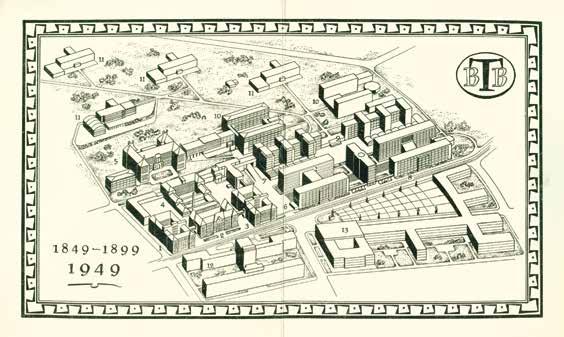
investment project in the modern history of BUT and required a total of more than 700 million CZK.
From the honours and awards that BUT has received recently, let us mention at least the visit of Prince Charles, today’s King of the United Kingdom, Charles III, which took place on October 31, 2000, or the historically first visit of the American ambassador Craig R. Stapleton on May 7, 2003. From October 19 to 21, 2006, the University hosted a Conference of the Association of European Universities (EUA) with the participation of several hundred rectors and prominent personalities of academic life from all over Europe. An important achievement of 2008 was the placement of a joint project of the Brno University of Technology, Masaryk University in Brno and other Brno universities and institutes of the Academy of Sciences of the Czech Republic on the “short list”, which led to the implementation of a unique supra-regional project with the ambition to make Brno a centre of scientific excellence. On November 26, 2010, the then Rector of BUT, Karel Rais, received the Czech One Hundred Best award on behalf of the school, where in the field category of Health-Education-Humanity BUT was ranked among the seven best institutions in the Czech Republic.
After years of demanding preparatory work and approval procedures in Brussels and at the Ministry of Education, the project of the “Centre of Excellence” CEITEC – Central European Institute of Technology was launched in 2011. In March 2015, the Czech Republic won the award for the best European innovation for the first time ever. It was for the unique Hydal biotechnology, which was patented by Ivana Márová’s team from the Faculty of Chemistry. In the same year, the Czech pavilion received a bronze medal at EXPO 2015 in Milan. A trace of BUT can also be seen behind it, as its designers Ondřej Chybík and Michal Krištof are graduates of the Faculty of Architecture. Finally, in 2017, Martin Hartl, Ivan Křupka and Petr Šperka from the Institute of Machine and Industrial Design of the Faculty of Mechanical Engineering were awarded the Alfred E. Hunt Commemorative Medal for their scientific work.
10
HISTORY
Plan for the completion of the campus at the foot of Kraví hora according to a project from 1949
HOW HISTORY AFFECTED BUT STUDENTS’ LIVES
In modern Czechoslovak history, the lives of the BUT students were often affected by turbulent moments, whether it was World War I and II or communist totalitarianism. A high number of teachers and students died during World War I, many others became heroes of the anti-fascist resistance or lost their lives in concentration camps. Others then struggled with political oppression in the era of communist dictatorship.
JANA NOVOTNÁ / PHOTO ARCHIVES OF ZDENKA VESELÁ, JIŘÍ KRAUS AND TONY ZIMMER
The dramatic moments in the history of the Brno University of Technology have been well described in Jiří Pernes’s book KapitolyzdějinVUT v Brně(ChaptersfromtheHistoryof theBrnoUniversityofTechnology)
The author describes in detail, for example, the situation following the unexpected occupation of the Brno University of Technology by the Germans on November 17, 1939, when some students did not let their teachers persuade them to keep the peace and leave for home. A turbulent mob gathered in front of the school building on Veveří Street and marched towards the city centre, where the students were beaten up and the crowd dispersed on Žerotínovo Square. Later that day, 13 students were arrested. “The arrests continued inthefollowingdays–fromNovember 29 to December 7, another 65 students of Czech universities in Brno endedupinaGermanprison,andon December13theyweretransported toVienna,fromwheretheyweresent to the Sachsenhausen concentration campinJanuary1940. (...) Very difficult times awaited them there, forwhichtheywerenotprepared atall,” said Pernes. Of the students who did not return to school after the war, we can mention, for example, Libor Zapletal, who enrolled at the the Czech Technical University in Brno in the autumn of 1939. The Germans closed the schools before
he could start studying. He died as a hero as a member of the Bivouac airborne group. A similar fate befell Petr Haas, a student who gave his life as a soldier of the Czechoslovak Foreign Army or Augustina Feinerová, a student of chemical engineering who died in a concentration camp, and many others.
But it was not only the wars that affected student’s fates. After the communist coup in February 1948, purges were ordered at Czech universities, followed by expulsion of students for political reasons. As a result of the so-called democratization of universities, many students who were inconvenient for the communists had to terminate or interrupt their studies. The BUT Archives contain materials documenting various reasons for expulsion, which come from the documentation of the former Department of Chemistry and Mechanical Engineering of the Brno University of Technology from 1948–1951. For example, the decision of the University Action Committee to interrupt studies of certain students, who were allowed to return to their studies only after working a certain amount of time in the Zbrojovka arms factory, mines or on road construction, while their further study was subject to approval of the Regional Communist Committee or by the Ministry of Education. The reason for
expulsion could be sloppy attendance and late arrival at lectures, and then all it took was to fail an exam and the student’s fate was sealed: “Expelled duringthedemocratizationofuniversitiesin1949forpoorgrades.”
Another surviving document testifies to the alleged “lossoflegalcapacitytoacquireanacademicdegree, andthusthelossoftheabilityto studyatauniversity”. These were students who had been convicted of a crime, usually an act under Act No. 231/1948 Coll., for the Protection of the People’s Democratic Republic. Another justification for not readmitting the student after the “interruption of studies” was: “Given that he did not engageinmanuallaborinproduction, but worked as a seasonal chemist in asugarrefinery,theRegional Communist Committee does not recommendhisapplicationforpermissiontocompletehisstudiesatthe DepartmentofChemicalEngineering oftheTechnicalUniversityinBrno beapproved.” It remains to be seen how many of the cases served as a mere cover for the regime to prevent “inconvenient” students from obtaining university education, but what is certain is that considerable pressure was exerted to reduce the number of students and redirect them to construction and heavy industries.
Persecution by the totalitarian regime continued until the mid-1980s.
11 STUDENTS
STUDENTS
Applicants with unsatisfactory political profiles were not allowed to study at all, and students who failed to demonstrate proper loyalty to state power were persecuted. It often ended up with their emigration or the departure of the student from the school, in one case even with the unexplained death of a student who made no secret of his critical attitudes towards the official policy of the time. Read the stories of some students who were not lucky enough to live in a time of freedom or who managed to miraculously trick their fate.
ZDENKA VESELÁ GRADUATED THANKS TO HER CLASSMATE
Following in the footsteps of her father, Zdenka Veselá (1928–2021) decided to study electrical
engineering and, despite adversity, never stopped professing the values of education, service to the nation and the idea of the Sokol, a Czech national gymnastics organisation. Zdenka’s grandfather Rudolf Londin co-founded the Sokol in the Vsetín district and Zdenka’s mother met her future husband at a Sokol festival. Her father came from a poor background, but at the age of twenty-three, and with a borrowed two hundred crowns, he started a factory manufacturing electric motors in Vsetín. He received numerous patents in the field of electrical machines, thanks to which he earned the nickname Moravian Edison. He provided work for fathers of families, ensuring them a dignified life and the opportunity to provide an education for their children. He instilled the same in his own children. “Zdenka,studydiligently,the newrepublicneedseducatedand
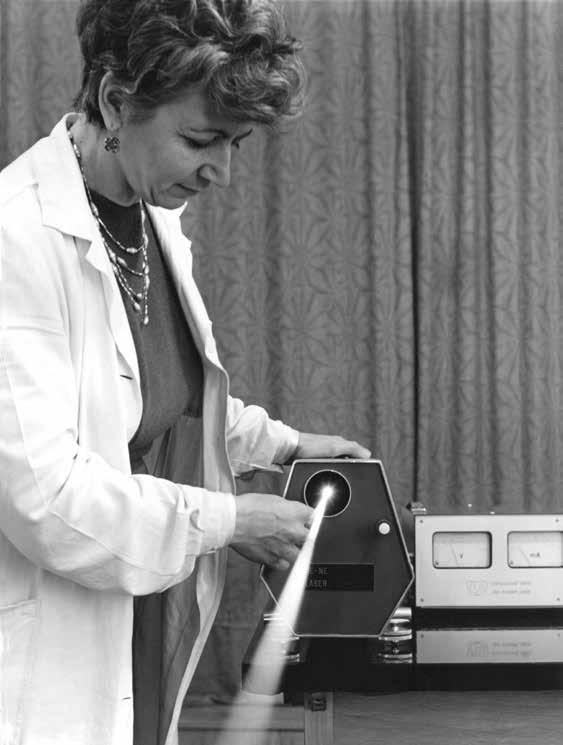
hardworkingpeople,“ – this is how Zdenka recalled her father’s words at the age of ninety.
He received tempting job offers from both Europe and America, but as an ardent patriot, he turned the offers down. During the war, he organized the resistance and in 1944 he was arrested by the Gestapo, tortured and murdered. As a fourteen-year-old, Zdenka herself joined Sousedík’s resistance organization. Her father’s example was a great commitment for her. After graduating from grammar school, she studied at the Faculty of Electrical Engineering at the then Dr. Edvard Beneš University of Technology in Brno, although it was not easy for her. Communist purges were being carried out at the school, and she was labelled as “a daughter of a capitalist” in her materials. At the last minute, her file was destroyed by a classmate who knew their family well, so she miraculously managed to stay in school. A year before graduating from the Technical University, she joined the Department of Electrical Technology as a research assistant and later she worked as an assistant. It was here that she met her future husband, Lumír Veselý.
After the establishment of the Military Technical Academy in 1951, Mr. and Mrs. Veselý were allowed to stay at the school; nevertheless, Zdenka was not allowed to stay for long. “At the militaryacademy,thecommunists keptholdingtheirmeetingsallthe time.MyhusbandandIwere preparingexercisesandwrotetextbooks,” said Zdenka Veselá recalling the unhappy time. In 1957, during the transformation of the school, she was reminded of her “capitalist” origins and was dismissed. She supplemented her knowledge of the field by self-study of professional literature and after four years she was admitted to the Institute of Scientific Instruments of the Czechoslovak Academy of Sciences, where she worked until her retirement in 1991. She contributed to the achievement of the top results of her department in the development of gas helium-neon lasers, a number of patents and professional articles bear her signature, and she also contributed to the introduction of the treatment of non-healing wounds by means of custom-developed lasers.
12 STUDENTS
Zdenka at the laser
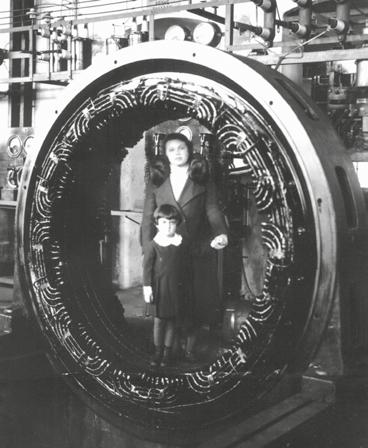
After the Sokol was re-established in 1990, Zdenka Veselá rejoined the activities of the Sokol in Brno-Královo Pole. In 2000, she and her husband were still active at the All-Sokol Rally in Prague. In 1991 she received an official certificate of a resistance member and then received a number of awards for merit in the anti-fascist resistance and in the Sokol, including the War Veteran Certificate. From the post-war years, she was regularly meeting Antonín Bartoš, the commander of the Clay-Eva paragroup in Vsetín, and the last time they met was in 1995 in New York. Even during the celebration of her 90th birthday, she was recalling Masaryk’s Czechoslovak Republic, Sokol and its ideals – love of one’s homeland, care for others and an honest life – all the wonderful things that once helped to build the young Czechoslovak Republic.
JIŘÍ KRAUS FINISHED SCHOOL ALMOST MIRACULOUSLY
In March this year, we commemorated the 94th anniversary of the birth of Jiří Kraus, a graduate of the Brno University of Technology, whose life was badly affected by the Communist coup in February 1948. Nevertheless, by a lucky coincidence, he managed to graduate from the Faculty of Architecture and built a number of important buildings in the period of oppression. He naturally developed his critical view of the political
situation after the communist coup in 1948 due to his family history. His mother came from a farm that was confiscated by the communists, his father was an enthusiastic Sokol member and a follower of the ideals of T. G. Masaryk. Membership in the Sokol and the Scouts strengthened Jiří’s feeling that democracy must be protected at all costs. After both organizations were banned, he was meeting with his friends secretly, and in mid-1948 they founded an anti-communist group. Jiří graduated in 1949, but he did not receive a recommendation from the local communist organization to study at university. “In ourillegalgroup,weagreedthatsome ofuswouldfleetoEngland,from wheretheywouldsendinstructions and tasks to those of us who would stay,” said the witness. The escape failed, the friends were arrested by a Soviet patrol after crossing the border, and in the autumn the Kraus’ home was raided by the communist secret service. “Theyturnedthe apartmentupsidedown,handcuffed meandtookmeawayforSovietstyleinterrogation.Iwentthrough interrogationsaccompaniedbybrutal torture, in the end Ialwayssigned something,butI didn’t confess to anything.Asamemory,I was left with aperforatedeardrum,frequent otitismediaandspinalpain,” recalled Jiří Kraus. In January 1950 he was sentenced to heavy imprisonment, a fine and the loss of his civil rights. The young man’s next journey led to the Litice quarry and from there to the Vykmanov camp, from where the prisoners were transported to the Jáchymov uranium mines. After eight months of work, Jiří Kraus ended up in a cave-in and when he was released home a few days later, he weighed 48 kg.
He began working as an unskilled worker and was constantly assured that the shovel would be his only tool for the rest of his life. Nevertheless, he repeatedly applied to college. In 1954, he asked his relatives in Brno to find out when the entrance exams to the Brno University of Technology, where he wanted to study architecture, were taking place. He applied, and when he did not receive any answer, he went to Brno on the day of the exams and claimed he had been invited. He was subsequently added
to the list and underwent tests, but he was waiting for the results in vain. His relatives found out when the enrolment day was, and the tireless applicant moved to their place and went to the dean’s office to pick up his student’s record book. “When the studydepartmentsearchedunsuccessfullyformeinthelistofadmitted applicantsandI said when I took the entranceexam,theyfoundmeat the bottom of the list and I received mystudent’s record book. I started attendinglecturesandpreparingfor exams. It was not discovered that I had been admitted until after the first examination, when the result was to be entered in the student’s record book.” His Brno relatives intervened again and, with help of their friend, arranged for Jiří to meet Bohuslav Fuchs, the then dean of the faculty. When the student told him his story, Fuchs made sure that he was allowed to study in secret – his exams were recorded, but he was never listed as a regular student until his request for the expungement of his sentence was approved. Only then were the documents of his study verified, and in 1960 the young architect graduated without ever being officially accepted.
In 1958–1959, Jiří Kraus even passed the dreaded screenings unnoticed by the Communist party, while his intercessor had to leave the school after a staged accusation. “I have thehonourofbeinga student of Professors Bohuslav Fuchs and BedřichRozehnal,whowereamong ourmostimportantarchitectsofthe 20thcenturyandwereourtruerole modelsbeforetheCommunistregime left their mark on them. The new professorswhoreplacedthemtried toconvinceusthatitwasonlyunder socialismthatitwaspossibletowork freely.However,soonafterI started working,Ifoundouthowprescient BohuslavFuchs’wordswere,telling ustovaluethetimeofstudy,because itwasourlastchancetodesign freely,” recalled the graduate of BUT’s Faculty of Architecture.
After school, he joined the Stavoprojekt company in Hradec Králové, where he led the Studio for the Reconstruction of Monuments. When he obtained the position of the Head of the Stavoprojekt hub in Pelhřimov in 1966, a new stage of
13 STUDENTS
Zdenka with her mother in the stator of an electric motor in her father’s factory
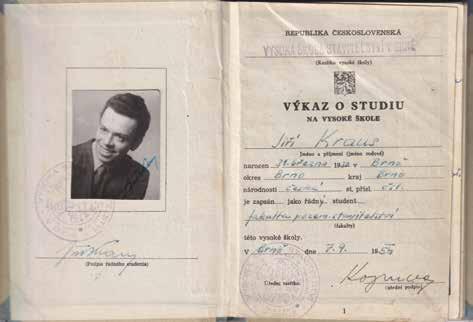
his life as an architect began. As he himself says, in Pelhřimov he really felt like an architect even with all the restrictions that the time brought along. One of his first works was the housing estate in Kamenice nad Lipou, and another project that is still recognized today was the Osvobození housing estate in Pelhřimov. “Iproceeded in the same wayasduringmyfirstdisobedience and presented the Ministry with the documents they wished to see. They didn’tfigureoutthatthedesigns werelaterchanged.” In Pelhřimov, he also designed the award-winning Na Pražské Elementary School, where some of the pavilions were standardized, but again modified according to the teachers’ requirements. He then designed many school buildings across nearly the whole South Bohemian Region. In the 1980s, the Ema Destinnová Elementary School in České Budějovice was awarded the Building of the Year. “Although the material and formal possibilities of the construction at that time were verylimited,JiříKrausdidnotstop strivingforhigh-qualityandfunctional architecture,” said architecture theorist Vladimír Šlapeta.
After the Soviet invasion in 1968, Jiří Kraus played with the idea to emigrate, but in the end he stayed. “Atthattime,I came across the Universal Declaration of Human Rights,andIkeptdistributingitto myfriendsuntil1989.Between1948 and 1989, Imadeseveralcopiesof KarelČapek’sessay Why I Am Not a Communist, and I also disseminated itonappropriateoccasions.” As a representative of political prisoners,
he was also a member of the K-Club of the Hannes Seidl Foundation based in Munich, a worldwide organization helping the post-totalitarian states, where he held the honorary position of the chairman for several years. At the time of writing this article, he expressed the hope that he had contributed at least in a small way to the establishment of democracy in our country. “Ihaveremainedtruetomy convictionsandthoseofmyparents. Iamremindingyouofeverything Ihaverepeatedlywrittenandsaidso thatitwillnotbeforgotten...”
ANTONÍN ZIMMER EMIGRATED
Antonín Zimmer (1943) studied civil engineering at the Brno University of Technology, yet he can be described as one of the first “IT guys” from BUT. His promising career was interrupted in 1968 by the Soviet occupation when the young technician decided to emigrate. With the new name Tony Zimmer, he spent his professional life mostly in Canada, where he settled permanently.
He entered the Faculty of Civil Engineering at the Brno University of Technology in the autumn of 1960. As a result of the restructuring of the faculties, the teaching rooms were scattered throughout the city, which meant considerable time losses for students and teachers. “However, one of our first lectures was held in thehistoricalbuildingoftheFaculty ofCivilEngineering,atthattime occupiedbytheMilitaryAcademy, where Professor Bezdíček lectured us onIntroductiontoCivilEngineering,”
recalled the BUT graduate, for whom the main place of learning was the building of the former seminary for priests in Barvičova Street. He lived in the dormitories, which were wooden barracks that the Germans had built as a concentration camp during the war, and where in winter snow blew through the cracks in the walls. “Someoftheboysslept inclosedwardrobesputonthefloor sotheywouldn’tfreezetodeath,” recalled the witness, who in his first year of studies also experienced the student May Festival. “In the second year,Ididn’tmakeittotheMay Festivalparade,andthatwasmyluck, because the communist authorities dislikedtheanti-regimeslogansand myclassmateswhocarriedthem wereexpelledfromschoolforayear andhadtoatonefortheirsinsby workingonconstructionsites.”
Already in his second year, Antonín Zimmer began working as a research assistant at the Department of Structural Mechanics, and it was then, during endless hours of work with a mechanical calculator, that he realized that the future belonged to computers. He enrolled in the LGP30 computer programming course led by Zbyněk Drahoňovský, and completed it with an ever-increasing interest in computer technology. In the third year, the students were divided into three fields of study and only the “best of the best”, including Antonín Zimmer, got into the field of Constructions and Traffic Structures. At the beginning of the fourth year, the talented student received an unofficial offer from Vladimír Kolář to stay at the Department of Structural Mechanics as a specialist in the field of computer synthesis and structural mechanics: “I was one of the first tocompleteanindividualstudywith a computer-construction-constructivefocus.Anotherbenefitwaseasy accesstoprofessorsandstudy materials, and Ievenhadmyown office.”
In the fifth year, Zimmer continued his individual studies, at the same time doing programming “moonlightings” and, under the supervision of Vladimír Kolář, working on his diploma thesis, the results of which he was to program on a computer. “I didn’t haveanymoremachinetimefor
14 STUDENTS
Jiří Kraus’ university student’s record book
debugging,soitwasdecidedthat a programwritteninthepublishing versionoftheALGOL-60language andintheassemblylanguageforthe Minsk-2computermustbesufficient.
After asuccessfuldefenceofmy thesisandsubsequentgraduation, I became agraduatecivilengineer.”
In the autumn of 1965 he took up the promised position at the department, and although he had to go to the army in February 1966, during his military service he took part in a course in programming the Swedish SAAB D-21 computer, which was installed at that time in the Laboratory of Calculating Machines at the Brno University of Technology. “Aftermilitaryservice, I continued with what I had started –theapplicationofthefiniteelement method,thetheoryofsourcefunctions,suspendedcablestructures andmanyothertasksoncomputers.
In the autumn of 1967 Ijoinedthe DepartmentofSteelStructuresas an assistant to Professor Lederer, theauthorofthelegendaryPavilion Z of the Brno Exhibition Fair, and in thespringI received an invitation to a postgraduatestayatthe UniversityofZagreb.However,this failed to materialize because of the invasion the Warsaw Pact countries inAugust1968.” Antonín Zimmer did not hesitate, he arranged a passport and a visa to Austria and waited for the right moment. “Intheautumn, Iwassupervisingstudentswhowere helpingoutduringapotatoharvest, andthatwasmylastprojectatBUT. On November 11, Imetmyunclein Vienna, and on November 22, I was in Toronto.”
He admits that the decision to emigrate was not difficult for him. He had been trying to find a job abroad since the autumn of 1967, and the Soviet invasion of August 1968 only greatly helped to achieve this. On his way across the ocean, he tore an ad from a Toronto newspaper in which a fledgling computer company, Computel, was looking for system programmers. “ThenextdayI handed over the advertisement to the employment office in Toronto, went throughaninterviewandafortnight later IstartedinOttawa.InEnglish,I could barely eat and drink and read a little, but I was able to work with a computer.Mycolleaguestookturns with me and after a few months I had
noproblemswiththelanguage,” said Tony Zimmer, recalling his time at the first Canadian company to rent computer time. But he wanted to do engineering work, so he soon applied for membership in an organization that grants MSc. degrees and passed the exam. After another two years at the Ministry of Public Works, he and several colleagues founded Group Five, an engineering computer systems company. There he experienced the most interesting period of his career, he got to Australia, the Middle East, and travelled all over Canada. In 1985, he sold the company to a partner and took a job at the Canada Post, where he began working on artificial intelligence and making decisions about computer purchases. When he wanted to retire after eighteen years, CGI, a Canadian company, offered him a position,
where he stayed for another ten years. And so, as he says, he did not really settle down until he was 69 years old.
He has never regretted his decision to choose Canada as his new homeland. Thanks to the Internet, the world is much smaller today than it was fifty years ago, so it is easy to be in touch with his old friends and with Czech culture. When remembering his alma mater, he emphasizes that it really gave him the essentials for his life. “Aboveall,Ilearnedtousemy own brain, and in addition, Igained the theoretical foundations that are absolutelynecessaryforengineering. When Icomparedthequalityof myeducationwithmycolleagues inCanada,theBrnoUniversityof Technologycameoutverywell,” concluded Antonín “Tony” Zimmer.
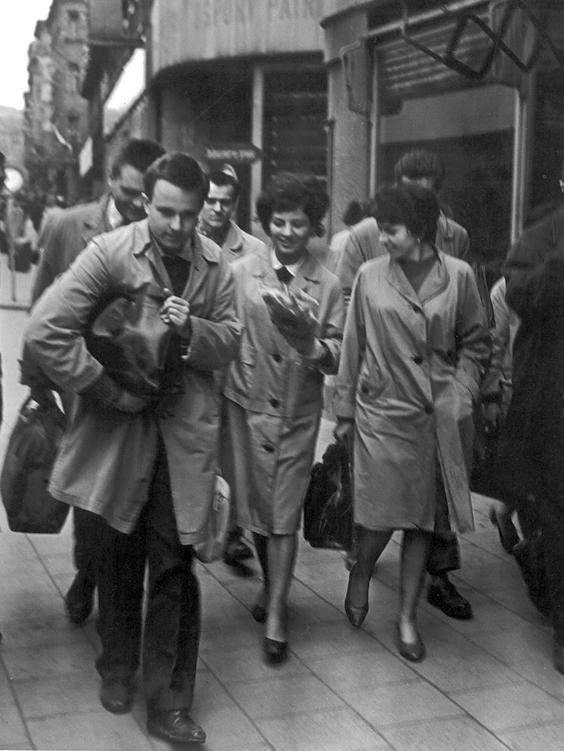
15 STUDENTS
Tony Zimmer with his classmates on Masarykova Street in Brno in 1961, the street was later renamed Třída Vítězství (Victory Avenue)
BUT FROM A TO Z
Let’s recall the significant phenomena associated with higher technical education in Brno.
ARISTOCRACY
From its beginnings, technical education in Brno was associated with the aristocracy, which held key positions in the public life of the Habsburg monarchy throughout the 18th and most of the 19th centuries. The first important nobleman in this respect was the gubernal councillor for study affairs, Marquis Karel de Ville, who in 1778 was instrumental in moving the engineering academy from Olomouc to Brno. With this decision, he established a centuries-old tradition of teaching technical sciences in the Moravian metropolis, which continues to this day. The proposal to establish the first technical school, promoted to a technical university in Brno in 1873, was presented at the meeting of the Provincial Assembly in January 1849 by Count Jan Alfons Serényi, supported by the Prince of Salm-Reifferscheidt, Count Lazansky and Knight Chlumecky. The press of the time supplemented this report with an explanation that “technical schools are, according to their name, those where the basics of various arts, industries and crafts are taught, while other schools are for mere learning, these serve practical needs“. The Moravian provincial nobility, which traditionally supported the German Technical Institute, did not have much understanding for the establishment of the Imperial and Royal Czech Technical University in Brno, but one exception was found. It was the Czech patriot and supporter of Brno students, Václav Robert, Count of Kaunitz, who in 1908 donated his palace in today’s Kounicova Street to the Czech Technical University and at the same time founded the Kounic Student Dormitory Association.
On the occasion of the celebration of the twenty-fifth anniversary of the establishment of the Czech Technical University in Brno, the completed dormitories were ceremonially handed over to the students.
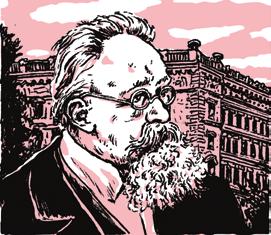
The work of Count Kaunitz and his importance for the Czech Technical University is still commemorated by a large relief depicting his castle in Austerlitz on the side façade of the Faculty of Civil Engineering of the Brno University of Technology.
BUILDINGS
Technical schools in Brno had a significant impact on the intellectual life of the city, but during the 19th and 20th centuries they also fundamentally influenced its architecture and urbanism. At the beginning, they were housed in older buildings. In the 18th century, the oldest one, the Engineering Academy was moved into the abolished Jesuit college, and the technical school found its first refuge in a building in Dornych. It was not until 1860 that the German Technical University acquired its own building. The large building built on today’s Komenského Square was one of the largest and most dignified buildings on the Brno ring road, where
the Technical University was located until its end following World War II. The Czech Technical University, first located in Jaselská and Gorkého Streets, had to wait until 1911 for its representative headquarters, when a large neo-baroque building was completed in Veveří Street. It was designed by architects Michal Ursíny and Josef Bertl. During the 20th century, the Czech Technical University acquired or built other buildings, in which students of eight faculties and three units are now educated. These include, for example, the Faculty of Information Technology, located in the former Carthusian monastery in Královo Pole, or the campus of the Brno University of Technology Pod Palackého vrchem with the unmissable Faculty of Mechanical Engineering, whose lecture halls are located in a building designed by architects Antonín Kurial, Antonín Krasický and Jaroslav Ledvina. The Faculty of Fine Arts uses the premises of the former Land Defence Barracks on Úvoz. The BUT Rector’s Office operates in the neo-Baroque building of the former episcopal alumni on Kounicova Street. Today, Brno University of Technology operates both historical buildings and modern research centres with the best technologies.
CYCLE
The history of the Brno University of Technology, which spans the entire 20th century, is a constantly repeating story of ups and downs. The establishment of the Imperial and Royal Czech Technical University bearing the name of Emperor Franz Joseph I was a great victory for Moravian patriotic circles. The University experienced a great period during the First Czechoslovak
16
GLOSSARY GLOSSARY
MICHAL KONEČNÝ / ILLUSTRATIONS BY ONDŘEJ BODLÁK
Republic, when several outstanding personalities and promising students worked there. The importance of the school was also recognized by the state, which intended to build several new buildings for it on the planned academic square near today’s Faculty of Civil Engineering. Instead, however, came the German occupation, and soon after the closure of the University, whose buildings and property were partially taken over by the German Technical University. None of this, however, was as painstaking as the sacrifices of teachers and students who died on the scaffolds or in concentration camps during the war. The Dr. Edvard Beneš University of Technology was re-established shortly after the end of the war. Its future seemed bright, as it took over the administration of most of the buildings and property of the German Technical University, which had been abolished by a decree of the President of the Republic. Soon, however, the University and the entire state were taken over by communist totalitarianism. Many important personalities were expelled from the school, the new management introduced collective study, the admission procedure underwent a transformation, and the dreaded purges were subsequently launched. In 1951, the ruling party finally decided to close the University, a substantial part of which was transferred to the administration of the Military Technical Academy. Only the Faculty of Civil Engineering and the Faculty of Architecture transformed into the University of Civil Engineering, defended their independence. The University was not re-established under the name of the Technical University until the thaw in 1956. Although the persecution of some important personalities continued, the opinions of students and teaching staff were inexorably directed towards the atmosphere of the Prague Spring of 1968. BUT established a number of contacts with foreign universities and hope and freedom had returned to its buildings. In August 1968, the democratization process was overwhelmed by Soviet tanks, casting the University into another dark chapter of Czechoslovak history. After the subsequent audits, a large part of the BUT management left, as did many officials at the faculties and then several teachers.
After February 1948, in most cases, they were replaced by politically compliant employees who remained in their positions until November 1989. The further rise of the University, inextricably linked to democracy and freedom, continues to this day.
DOCTOR HONORIS CAUSA
The honorary academic degree of Doctor Honoris Causa is awarded by university rectors together with the Scientific Council to important personalities who have contributed to the development of science, culture or society as a whole. The appreciation of the extraordinary contribution of people who often do not have a direct connection to a university largely reflects the social and political conditions of the entire country, and this was also the case with BUT. The first honorary doctorate was awarded by the University in 1909 to the patron of Czech students, Václav Robert, Count of Kaunitz. In 1913, the recognition of nobility was replaced by pragmatism, as the second honorary doctorate was awarded to the Minister of Public Works, Otakar Trnka, famous for his support of Czech business. In 1926, President Tomáš Garrigue Masaryk received his doctorate, followed by several renowned scientists and managers. The first foreign Doctor Honoris Causa of the Brno University of Technology was the president of the Academy of Sciences in Paris and the world-famous geophysicist Charles Lallemand. The honorary doctorate of BUT was also awarded to Edvard Beneš, Jan Antonín and Tomáš Baťa, Nikola Tesla, Václav Klaus and extraordinary scientific personalities often associated with the University –Otakar Kallauner, Jiří Kroha, Armin Delong, Viktor Rudiš, Bohuslav Woody Vašulka and Herbert Ossan.
EDUCATION
In the first academic year of the Czech Technical University in Brno, only civil and mechanical engineering was taught, with supplementary courses in land surveying. At that time, four professors took turns behind the desk, lecturing to fewer than fifty students. The management of the University intended to expand the teaching and to align with other technical schools, but the first change was not made until 1908 when the Chair of Constructive Electrical Engineering
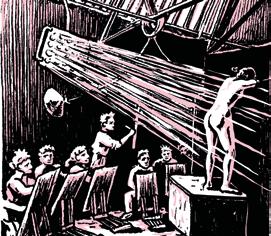
was established. Two years later, government circles decided to spin off a separate electrical engineering department from the field of mechanical engineering. In the academic year 1912/1913, this time in a new building, the University opened a chemistry department, which was quickly followed by the opening of several other departments and institutes, transforming the former technical school into a full-scale university. The humble beginnings that were met with the government’s lack of interest and the contempt of the German Technical University are a thing of the past. The University offers almost 350 study programmes in Czech and English, often taught by experts in applied science. In 2019, BUT was the first technical school in the Czech Republic to receive permission to grant institutional accreditation and thus decide on its study programmes. In addition to accredited study programmes, the University organises international workshops, conferences, education through the University of the Third Age and the Institute of Lifelong Learning, afternoon art courses at the Faculty of Fine Arts, and other scientific and popularization events.
FACULTY
BUT currently consists of eight faculties and three institutes, the history of which reflects the history of the University and the whole country. The first to be established was the Faculty of Civil Engineering, located in a historic building in Veveří Street, which was built at the beginning of the 20th century. Its headquarters is such a majestic symbol of the tradition and continuity of Czech technical university in Brno that the long forty years the building was used by the Military Technical Academy have almost been forgotten. The return of students and teachers in
17 GLOSSARY
1991 was a visible manifestation of changes and a new beginning of BUT in times of renewed democracy. Only a year after the establishment of the school, the Department of Machine Building was established, thus laying the foundations of the Faculty of Mechanical Engineering. After the establishment of Czechoslovakia, the Faculty of Architecture was founded in 1919, and thus the development of the University was suspended for many years. The Faculty of Electrical Engineering, the predecessor of the Faculty of Electrical Engineering and Communication, was founded in 1959. Most of the faculties and centres of BUT were established after the fall of communism. In 1992 it was the Faculty of Business and Management, followed a month later by the newly established Faculty of Chemistry. A year later, BUT opened the Faculty of Fine Arts. The newest faculty, located in the oldest building administered by BUT, is the Faculty of Information Technology, founded in 2002. Along with the faculties, the Institute of Forensic Engineering, the Centre for Sports Activities and CEITEC are also an integral part of BUT.
GENDER
From the 18th century onwards, only male students attended academies and colleges teaching technical sciences. Women were denied higher education, even more so in technical fields which were considered exclusively male disciplines. This situation began to change gradually in the second half of the 19th century, but the fact that the first woman did not enter the Vienna University of Technology as a guest student until 1908 speaks for itself. Brno seemed more accommodating in this respect. Although there is still not much information about the situation at the German Technical University, the first women appeared at the Czech Technical University already in first year of its existence. They were guest students Eliška Kozlová and Ludmila Šebestová, who attended the drawing courses of Professor Hanuš Schwaiger. Eliška Kozlová, a long-time headmistress of the Vesna school in Brno, had been a pioneer of equality since 1891 when she was the first woman to attend courses for the education of teachers of follow-up trade schools. Not only that: in 1936, she
was the first woman in Czechoslovakia to be awarded the title of Chief School Councillor for her lifelong pedagogical merits. Ludmila Šebestová was also an important teacher and executive director of Matice školská, a Czech education-promoting organization in Brno. From 1918 onwards, women were also allowed to attend courses in state accounting, but it was not until after the establishment of Czechoslovakia that real equality with men occurred at the University. From the school year 1918/1919 onwards, women were accepted as regular students, and in 1923 the first female Masters of Science were documented among them – Marie Haičmanová, Věra Hanáková, Irena Löwy, Slávka Vuletič-Donátová and Karla Sumcová. By the beginning of World War II, thirty students had obtained a Master’s degree at the Czech Technical University. The first doctorate was awarded to Antonína Rudavská in 1928. These names stand at the beginning of a great story, at the end of which thousands of female students and teachers form the identity of BUT today. Promoting gender equality is one of the main principles of the current direction of the University. In 2021, BUT received the HR Award, an international award in the field of human resources management. The European Commission has thus confirmed the position of the Brno University of Technology among European scientific research institutions.
HORIZON
For travellers, the horizon forms a visible dividing line, behind which everything unknown and unseen is hidden. Such a horizon represents the future for the management of any university. Each of the rectors of the Brno University of Technology, no matter what it was called during its existence, associated it with development, rise and fame. Some of them longed for more freedom, democracy, living and working in the truth. They certainly wanted to involve their University in international scientific life, they planned the establishment of other faculties and units, the improvement of education and the best possible employment of graduates. What is the horizon of the current BUT? The future of any institution depends on the needs of the entire society it serves.
Environmental and climate protection, sustainability, energy self-sufficiency and safety have thus become major challenges for BUT. Its experts are looking for solutions to alleviate the effects of poverty and other social problems, establishing professional and practical contacts with industries, and cooperating with other universities and scientific institutions. However, the main concern is education. The University intends to grow in global rankings, participate in international grants and research projects, open up to students and experts from all over the world, and support everything that will create the goodwill and prestige of BUT. These wishes, in which the past and the future seem to collide, can only be successfully materialized thanks to the solid foundations and traditions on which the University is built.
IDEOLOGY
During the 20th century, the identity of BUT was affected by various ideologies, which significantly affected and transformed the direction of the entire university. The first historical turning point at the Czech Technical University was conducted peacefully. Professors and most of the students accepted the establishment of Czechoslovakia with enthusiasm, and in the following years, the University became one of the important intellectual pillars of the young republic. The promising development of the University was interrupted by the Nazi occupation, which brought the first totalitarian ideology to its soil. Under its influence, the University was closed with consequent political and racial persecutions that both teachers and students fell victim to. The joy of liberation was soon replaced by another totalitarian regime, this time Communist, accompanied by purges, and finally by the abolition of the University in 1951. However, even this did not break the commitment of many of its teachers, who, as soon as possible, enthusiastically joined the process of the gradual political thaw of the 1960s. The events after the Soviet occupation brought another period of lack of freedom, and people who owed their positions mainly to membership in the Communist Party of Czechoslovakia and engaged in political positions were put in charge for many years. During their tenure, political education work and ideology became an integral part of the study
18 GLOSSARY
and functioning of the University. The influence of totalitarian ideologies ended in November 1989. Their repeated returns represent one of the biggest warnings in the long history of BUT.
JOSEPHINISM
A decisive influence on the establishment and form of contemporary technical fields in Brno was the reform efforts of the Viennese court during the reign of Maria Theresa, and especially of her son Joseph II. Both rulers intended to create newly established educational institutions that would educate an enlightened elite who, in the service of the state, would bring the monarchy into modern times. The court paid particular attention to technical specialization, which, according to the French model, was to give rise to a new profession –a civil engineer capable of grasping and rationalizing the public space of the state. In the empire of enlightenment, these engineers were supposed to build a system of roads, regulate water flows, introduce the most modern hygienic measures into cities, put into practice the latest scientific knowledge, supervise the form of architecture, or design state and government buildings. The engineer became an indispensable pillar of the country’s transformation and at the same time a symbol of rationality and modernity. Education was a key condition for the creation of such a profession. In 1778, the University moved from Olomouc to Brno and with it the Engineering Academy, which then functioned here. Its teaching focused mainly on mathematics, geometry and practical construction exercises. Graduates of the Academy then began to assert themselves in the newly established state and provincial offices, such as the provincial construction directorate or the road directorate, where they found employment at various levels. A number of students also worked in the service of the provincial nobility. Although the academy fell into insignificance during the first half of the 19th century, it laid the foundations for the functioning of other technical educational institutions, which culminated in the activities of BUT.
KNOW-HOW
In addition to education, the importance of technical universities lies
mainly in research and the development of scientific disciplines. During the existence of BUT, a number of outstanding personalities have appeared among its teachers and students, whose contribution to science is still unquestionable today. Their activities are followed by contemporary scientists who achieve excellent results in traditional technical fields and modern technologies connecting BUT with leading scientific institutions around the world. Research into semiconductor technologies, microscopy, and especially electron microscopy, space and aerospace technology, artificial intelligence and cybersecurity, and environmental engineering brings great results. The University is also successful in the field of architecture and fine arts. In addition to these activities, BUT’s activities have naturally expanded in recent years to embrace a third field of finance and business, which we refer to as knowledge transfer, and the University is thus open to cooperation with the commercial sector and public organizations with an emphasis on the focus of the field and currently burning topics. In the context of the Green Deal, these include, for example, electromobility, as well as accumulators and batteries, the circular economy, hydrogen and hydrogen technologies, waste management and the development of new materials. The results of science and research in the form of patents and utility and industrial designs are intellectual property that is protected at BUT.
LITERATURE
The first publications were released by the Czech Technical University in Brno before the foundation of the new school building on Veveří Street. These were lecture notes by Professor Vladimír List, supplemented by lithographs, which were published under the titles Direct Current Machines,Alternators,Transformers andElectricalEquipment. To this day, professional publications and scientific studies by academics with an international impact form – in addition to the teaching itself – the basis of University work. Their contributions appear in the Web of Science database, which monitors the citation rate of scientific articles and regularly updates bibliographic data. It would be unfair to omit literally kilometres of students’ final theses stored in the
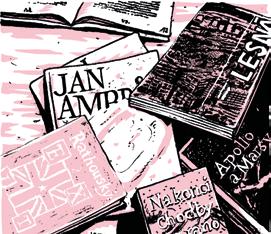
BUT Archives. Since 1996, publishing activities at BUT have been provided mainly by VUTIUM Press publishing house. Its most successful titles include textbooks, professional literature and books on art and architecture. A number of publications published by VUTIUM have received awards for their professional level or graphic design. Among the most important are the Josef Hlávka Award and repeated awards in the Most Beautiful Czech Book of the Year competition. In 2023, Michal Konečný’s book Apollo aMarsyas.PříběhuměnínaMoravě (ApolloandMarsyas.TheStoryofArt in Moravia) received recognition at the Autumn Book Fair in Havlíčkův Brod.
MOBILITY
Due to the size of the Habsburg monarchy and its several intellectual centres, the mobility of researchers and students has been an integral part of technical education in Central Europe since the 18th century. This fact is particularly evident in the lives of the personalities of the German Technical University, for whom Brno was only a transfer station in their often dramatic careers, influenced by the complicated history of the 20th century. As a result of totalitarian regimes and the political, social and racial hatred associated with them, many valued experts, architects and scientists have ended up in various places around the world. Mobility is also related to scientific contacts with foreign countries, which have been maintained at the Czech Technical University in Brno since the times of the First Czechoslovak Republic. Historical relations with universities and scientific institutions are best evidenced by honorary doctorates awarded to academics from France and cooperation with scientists from Belgium and Yugoslavia, accompanied
19 GLOSSARY
mainly by the personal friendships of some of the lecturers. In the second half of the 20th century, the University’s international cooperation was limited to Eastern Bloc countries for political reasons, although some scientists did not stop maintaining relations with colleagues on the other side of the Iron Curtain. After November 1989, these people became the leading figures of the University and its science. At present, the University’s mobility is ensured by extensive partnerships with technical universities around the world, of which BUT is an inseparable part. The main advisory body is the International Scientific Council of BUT, and relations with foreign countries are also used by a substantial part of the Erasmus+ project.
(I)NNOVATORS
Every innovator who promoted new changes, new ideas and extraordinary discoveries at the Czech Technical University and later at the Brno University of Technology, is permanently inscribed in the history of the institution. Innovators have always been women and men who, in addition to outstanding scientific results, possessed strong moral attitudes and a sense of democracy and freedom, which in the past often resulted in their forced emigration. At present, BUT achieves excellent results not only in traditional technical fields, but also in areas related to future technologies that are already mentioned under the headword Know-how. Thanks to the incorporation of the fine arts, architecture and design, the University connects the technical and artistic worlds, thus developing creativity in technical research and education in a unique way. Patents are granted to exceptional inventions that may find use in industrial applications.
OPENNESS
From the very beginning, the young universities, which were also established in the smaller towns of the Habsburg monarchy, had openness literally in their genetic code. The Czech Technical University was no exception. In order for it to be established at all, most of the teachers who had been working at other educational institutions throughout the empire had to move to Brno. The same applied to students who came to the University from
all parts of the country. In the second half of the 20th century, students from abroad began to arrive, coming to BUT exclusively from Eastern Bloc countries and their allies. In times of freedom, openness is one of the pillars of BUT’s identity. The University is involved in several international research projects, is a member of major international professional associations and supports the international mobility of students and academic staff. Almost a quarter of students come from abroad, and it is increasingly possible to meet foreign teachers, for whom BUT has developed its Welcome Service. Faculties across the University offer accredited study programmes in English, including lifelong learning programmes. Academic staff use mobility and internships to acquire knowledge contributing to the development of research and publication activities, to present results, to support joint scientific projects and to prepare and develop joint study programmes. Students can study in joint-degree and double-degree programs, where they spend part of their studies abroad and after successful completion, they receive two diplomas, one from their parent school and one from a foreign partner school. However, openness is not only about international relations. BUT supports equal opportunities and plurality of opinions, accepts all democratic political positions and, on the contrary, rejects any discrimination. To ensure and protect these values, the position of Social Security Coordinator (ombudsperson) has been established at BUT since 2023.
PARTICIPATION
Participation, based on the need to openly express opinions and influence the direction of BUT, is, like openness, one of the basic building blocks of the entire University. The functioning of the University is influenced by the opinions of its strategic partners, whose representatives are members of the scientific councils or in discussion forums open to entities outside the academic sphere. For the future of most scientific disciplines, broadly conceived participation with state bodies, industries and foreign or international institutions is also necessary. By long-standing tradition, the University perceives internal participation, which is based on discussions with academic staff and students, as

absolutely necessary. Their important suggestions develop mainly from the activities of the Student Chamber and the Academic Senate and form an integral part of the decision-making of the University management. It is impossible not to mention BUT’s participation in public affairs and the University’s aid in moments of crisis brought about by the Covid pandemic or the refugee wave after the outbreak of war in Ukraine. As always in the past, the promotion of participation and openness to opinions is one of the best indicators of the well-being of the University and its development.
RECTORS
During the one hundred and twenty-five years of the existence of the Czech Technical University in Brno and then the Brno University of Technology, it has been headed by fifty-four rectors in sixty-one terms of office. The appointment, work and legacy of rectors have always been closely related to the state of society and the situation in the state, which often resulted in their quick dismissal, but also in their repeated confirmation in office. Emperor Franz Joseph I appointed the mathematician Karel Zahradník, who came to Brno from the University of Zagreb, as the first rector of the University. In addition to Professor Zahradník, the personalities who led the University during the times of the Austrian monarchy also included the architect of the oldest University building on Veveří Street, Josef Bertl, the prominent architect Karel Hugo Kepka and Professor Vladimír List. The first rector of the University after the establishment of Czechoslovakia was Karel Ryska, a mechanical engineer and long-time dean of the Department of Mechanical and Electrical Engineering, who was followed by other outstanding scientists and experts, including the architect Vladimír Fischer, the mathematician Karel Čupr, the professor of
20 GLOSSARY
chemical engineering Otakar Kallauner and the architect Jaroslav Syřiště, who took up the post in September 1945 immediately after his return from Nazi prisons. The periods of ups and downs occurred especially during the time of communist totalitarianism when the University was headed by a devoted supporter of Stalinism, architect Jiří Kroha. Architect Vladimír Meduna also played a sad role in the history of the University. His two-year term as the Rector ended in 1968, only to be reappointed in 1970 to conduct purges of the University’s staff. During the period following the Soviet invasion, the position of Rector of BUT was held by Professor of Radio Engineering František Kouřil from 1976 to 1985. After November 1989, the first rector was Professor Arnošt Hönig, who was replaced by Professor of Mechanics Emanuel Ondráček. It was the beginning of a series of rectors who led the University through the period of recent decades, at the end of which stands the current rector, Ladislav Janíček.
SAPERE AUDE
One of the official symbols of BUT is the Latin motto Sapere aude –Dare to be wise. This idea was first used by the Roman poet Quintus Horatius Flaccus, from whom it was taken up by other great figures of European thought, especially the philosopher Immanuel Kant. In 1784, Horace’s saying became part of his answer to the question of what the Enlightenment was. Kant defined the fundamental current of thought of the 18th century as the liberation of people from their own immaturity, with which the ancient message of Sapere aude is inextricably linked. Critical thinking, the open acceptance of other opinions or knowledge, and the desire for knowledge are as relevant to the current identity of the University as they were in ancient Rome or Enlightenment Europe.
TECHNICAL EDUCATION
The emergence of technical universities in the 18th and 19th centuries was related to the accelerated transformation of the world and the growing influence of various industries on the development of all of humanity. For the Enlightenment elites, the civil engineer became the bearer of rationality, progress, modernity and optimistic visions. The importance of
this profession has survived to the present day. The rapid development of modern technologies, which are an obvious symbol of our presence, is as closely linked to technology as to any other field. Today’s technical universities produce the majority of experts from all industries who develop their innovations and create competitive potential. With regard to the importance of industry for the Czech state, they represent one of the most strategic parts of our society. Technical education is as important as it was at the time of its creation. Its support, as well as the interconnection of technical education with other scientific disciplines, thus represent a key investment in our future.
UNIVERSITY NOW
The Brno University of Technology is currently the fourth largest university and the second largest full-scope technical university in the Czech Republic. According to the latest statistical data from 2022, it offered 350 fields of study and 177 lifelong learning courses at eight faculties. The University was attended by 17,505 students in accredited study programmes and 214 self-paying students. In the same year, 8,172 students were admitted to BUT, who were educated and supported in their studies by 3,620 academic, scientific and other staff. Almost 25% of students come from abroad, so BUT fulfils the essence of an international university. A total of 517 students and 221 academic staff completed internships abroad. Almost 217,000 books are stored in 9 University libraries.
VISION
Ideas about what lies beyond the horizon of the present are just as important as the present itself. Great periods in the history of all universities are always accompanied by clear visions, the fulfilment of which a large and intricately structured institution should be focused on. The empty phrases of the totalitarian era have been replaced by the currently clearly formulated goals through which BUT should become one of the best technical universities not only in Europe but also in the world. Their pillar is education, based on the cooperation of the technical, economic and artistic disciplines. It is closely followed by the support and development of science in
cooperation with foreign universities, institutions and international teams that set global research trends and reach the best resources and projects. All this is related to openness to the world, which is manifested in particular in the growth of international study programmes strengthened by cooperation with all strategic partners. These visions can only be fulfilled by a strong and self-confident university with employees and students fully engaged in the widest range of educational, research, creative and artistic activities. Creating the best possible environment for this joint effort is another vision, the successful realization of which requires the commitment of each and every one of us.
GENERATIONS X, Y, Z
The functioning of the University has always been based on the cooperation of people of different generations. The division of the population into generations X, Y and Z is also significantly reflected in the relationships between academics and students. Today, Generation X includes a substantial part of the teaching and professional staff, who in many ways build on the work of their predecessors, respectable women and men whose lives and careers are often tied to the University to the present day. BUT students come mainly from Generation Y, i.e. the so-called millennials, and Generation Z. Generation Y is represented mainly among its PhD students, while Generation Z generates students of bachelor’s and master’s studies. Sociological data characterizing all of these groups point to their relationship to modern technologies. While Generation X was the first to come into close contact with computers, Generation Z is also referred to as the “net generation”. These differences, which are less abysmal in technical fields, can be bridged especially by open communication, which forms the basis of mutual cooperation. Sharing common goals naturally blurs generational differences, which become an advantage in such a set of operations. Generations X, Y and Z form the core of the University’s human resources, and the support of the continuous interconnection of their opinions, knowledge and experience is absolutely necessary for the further growth of BUT.
21 GLOSSARY
NOTABLE FIGURES OF BRNO TECHNICAL UNIVERSITIES
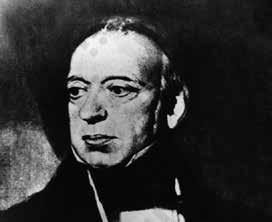
Salomon Mayer von Rothschild (1774–1855)
A representative of an important German and later Viennese banking and business family of Jewish origin, elevated to the noble rank. His business activities were also focused on Moravia and the Austrian part of Silesia, especially on the construction of the Emperor Ferdinand Northern Railway, the mining business and the Vítkovice Ironworks. Together with his advisors, he was also the spiritual father and organizer of the first railway with steam operation in Central Europe, an important shareholder of the Austrian Lloyd transport company and the organizer of the European monopoly on mercury trading. In 1847, he established a foundation to support the future Technical University for Moravia and Silesia in Brno, in gratitude for the imperial permission, which, despite his Jewish origin, allowed him to buy land in Moravia for his businesses.
He thus took the first step for the establishment of the then-technical school and today’s BUT. Salomon Rothschild was also an important art collector, focusing mainly on painters of the Italian Renaissance and French painters from the Renaissance to the Baroque. A collection of his paintings was acquired by the Louvre, and other works can be seen in the Kunsthistorisches Museum in Vienna.
Václav Robert, Count of Kaunitz (1848–1913)
The Czech aristocrat, politician and patron of the Czech Technical University in Brno was born in Dresden, but his mother was a Czech, who taught him to love his homeland from an early age. He studied law at the university in Prague and later graduated in Vienna. During his university studies, he was also an extraordinary student at the Higher School of Economics in Tábor. In 1883 he was elected a member of
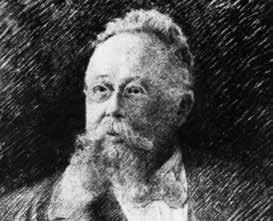
the Czech Provincial Assembly. In the following years, he repeatedly became a member of the Imperial Council, where he persistently advocated an eight-hour working day for workers, equal access to education for women, and the equalization of Czech and German at the then Charles-Ferdinand University in Prague. On the occasion of his marriage to Josefína Horová in 1908, he donated his palace on Žerotínovo Square in Brno for the needs of university students and established a foundation to build student dormitories. In 1909, the Czech Technical University in Brno awarded him an honorary doctorate. However, he did not live to see the construction of the dormitory complex in Brno-Žabovřesky, which still bears his name. The construction was not completed until ten years after his death according to the project of a professor of the Czech Technical University, architect Karel Hugo Kepka.
Antonín Rezek (1853–1909)
The Czech historian and politician studied history at the faculty of arts in Prague. Initially, he worked as a secondary school teacher and at the same time lectured as a private lecturer in Austrian history at Prague’s Charles-Ferdinand University, where he became a regular professor of Austrian history in 1889. However, a steep political career awaited him. In 1896 he was appointed court
22
PERSONALITIES
JANA FRANCHI, JANA KOŘÍNKOVÁ, JANA NOVOTNÁ
PHOTO BUT ARCHIVES, ARCHIVES OF THE CZECH ACADEMY OF SCIENCES, LITERARY ARCHIVES OF THE MCL, ARCHIVES OF VUTIUM PRESS, ARCHIVES OF THE NIKOLA TESLA MUSEUM IN BELGRADE, ENCYCLOPEDIA OF PRAGUE 2, ROBERT MUSIL LITERATURE MUSEUM
PERSONALITIES
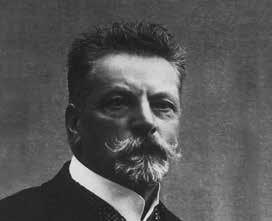
councilor for the Czech education department at the Ministry of Education and Culture, later becoming Minister without portfolio. In his lectures, he was mainly concerned with matters related to the Czech lands, so he was mainly concerned with the development of the Czech university in Prague and he also devoted great effort to the fight for the establishment of a second Czech university in Brno. Together with another Czech member of the Viennese government, Josef Kaizl, he played a crucial role in the establishment of the Brno University of Technology. As a historian, he was mainly interested in the Czech political history of the 16th and 17th centuries and the history of the Czech religious movement, which is why he is often referred to as one of the followers of František Palacký.
Nikola Tesla (1856–1943)
A native of Smiljan, Croatia, of Serbian nationality, he is considered one of the most important inventors in history. He studied mathematics and physics at the Polytechnic Institute in Graz, then transferred to Charles University in Prague. He worked in Budapest, Paris and, from 1884 until his death, in the USA. One of his most important achievements was the discovery of the rotating magnetic field, which later became the basis for the creation of the induction motor, which was cheaper and more efficient than the electric motors of the time. He was
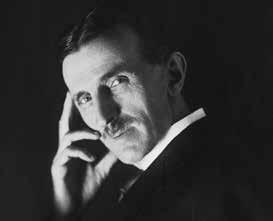
also a great promoter and inventor in the field of radio communication. He was the first in the world to publicly demonstrate a radio communication device. As a visionary, he predicted the advent of artificial intelligence. He was a promoter of the introduction of alternating current. In this respect, he clashed strongly with Thomas Alva Edison as a promoter of direct current. In the end, Tesla’s concept prevailed in the “War of the Currents”, and alternating current became the standard for electricity distribution. Tesla was hired by Westinghouse, a major electrical engineering company, which used his ideas. During his lifetime, he received many awards and distinctions. In 1936 he was awarded an honorary doctorate by the Czech Technical University in Prague, a year later he also received it from the Czech Technical University in Brno, and in the same year he received the highest Czechoslovak state award, the Order of the White Lion.
Josef Sumec (1867–1934)
Although he received a doctorate in philosophy in Rome, his interest in physics and electrical engineering led him to study mathematics and physics at the Czech University in Prague. He started his career in Darmstadt at the Electrical Engineering Institute of Professor Kittler, later he worked in the Brno company Bartelmus, Donát a spol.,
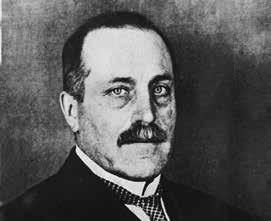
where he was mainly engaged in calculations and the production and testing of machines. In October 1902 he was appointed Associate Professor of General and Special Electrical Engineering at the Czech Technical University in Brno, and he became a full professor five years later. He worked there for thirty years until 1932 when he asked for retirement for health reasons. He was the Dean of the Department of
Mechanical and Electrical Engineering three times, and in one academic year, he also served as rector. He gained the attention of the electrical engineering world with several works in which he explained the physical phenomena of electrical machines and other branches of electrical engineering in a classic way. Its importance in solving the problem of the so-called circular diagram, which can be used to monitor the dependence of electrical quantities on the load of the machine, cannot be overlooked. He also devoted himself to acoustics and music, especially the tuning of keyboard instruments. He was close to Leoš Janáček, with whose assistance he constructed harmoniums.
Viktor Kaplan (1876–1934)
Austrian engineer and inventor of the famous Kaplan turbine. He first studied at the Technical University in Vienna, then in 1903 he entered the German Technical University in Brno, where ten years later he became the head of the Department of Theory and Construction of Water Engines. It was here that he made most of his key discoveries. He worked steadily to improve the already well-known Francis turbine until he finally developed a completely new type of propeller that still bears his name today.
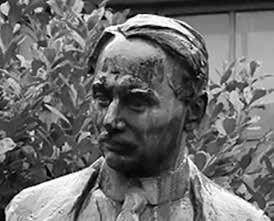
He devoted a great deal of energy not only to the discovery of this unique device but above all to the process of patenting it. The Department of Fluid Engineering of Viktor Kaplan at the Faculty of Mechanical Engineering of BUT has more than a hundred years of tradition. Kaplan’s bust by sculptress Sylva Lacinová, which is currently located in front of the building of the Faculty of Fine Arts of BUT on the corner of Úvoz and Údolní streets, will also be moved here shortly. To this day, BUT maintains friendly contacts with Kaplan’s descendants,
23 PERSONALITIES
especially with his granddaughter Gerlind Weber. Viktor Kaplan filed a total of 280 patents in 27 countries during his lifetime. In 1926 he was awarded an honorary doctorate at the Czech Technical University in Prague, and in 1934 at the German Technical University in Brno. In 1954, Viktor Kaplan was awarded the Rudolf Diesel Medal. The anniversary of his birth has been a UNESCO World Cultural Anniversary since 1976.
Vladimír List (1877–1971)
The founder and main creator of the electricity system of our country, the designer of many power plants and an enthusiastic sportsman, he studied at the Prague Technical University. After a study stay in Liège, Belgium, he worked as a chief engineer for František Křižík. From 1908 to 1948 he worked as a regular professor at the Czech Technical University in Brno, where he built new laboratories and founded the Institute of Constructive Electrical Engineering. He was elected dean three times and also served as rector. He was the Chairman of the Czechoslovak Electrotechnical Association and played a significant role in the creation of technical standards and their implementation in practice. His name is associated with the establishment and development of the Czechoslovak Standardization Society and the Czechoslovak Electrotechnical Association.
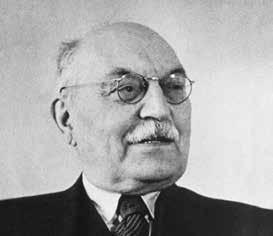
He also participated in the first Prague metro project modelled on other European cities. As an author or co-author, Vladimír List wrote more than 600 professional books, textbooks and articles. His publication Normalisace (Normalization), published in 1930, significantly influenced the standardisation of components of Czechoslovak engineering and electrical products.
He won several important awards at home and abroad. In 1947, he was the first professor at BUT to be awarded an honorary doctorate of technical sciences.
Robert Musil (1880–1942)
Austrian novelist, playwright and essayist, son of Alfred Musil, a professor at the German Technical University in Brno, studied at military schools in Eisenstadt and Hranice.
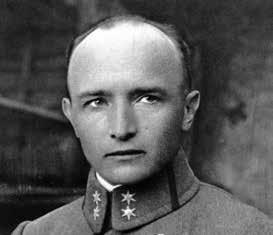
In 1897 he began his studies at the Technical Military Academy in Vienna, and a year later he transferred to the German Technical University in Brno, where he completed his studies with a Master’s degree. He took up work in the technical laboratories at the University of Stuttgart, and from 1903 he began to study philosophy and psychology in Berlin while working. He was strongly influenced by Friedrich Nietzsche, Fyodor Dostoevsky and Rainer Maria Rilke. In 1906, Musil published his first novel and, after a favourable reception, he left a promising engineering career in 1908. For example, he patented a chromatometer, the so-called Musil’scher Farbkreisel. In 1919–1920 he worked as an advisor to the Austrian Ministry of War, but from then on he devoted himself to writing and journalism. During World War I, he fought on the Italian front. In 1916, during a visit to Prague, he met Franz Kafka. Thomas Mann was also one of his admirers. He became a leading representative of modernism. His most important work is the three-volume novel The Man Without Qualities. It is interesting to note that his short story Tonka tells the story of his time in Brno. After the annexation of Austria by Hitler’s Germany, Musil’s books were banned and Musil and his family went into exile in Switzerland, where he died. During his lifetime, he received
the Art Prize of the City of Vienna (1924) and the Gerhart Hauptmann Prize (1929).
Bohumil Markalous (1882–1952)
The writer, journalist, art aesthetician and critic is better known under his literary pseudonym Jaromír John, which he used as an author of short stories and novels. After completing his university studies at the faculty of arts in Prague, he worked alternately as a teacher at secondary schools. During World War I, he took an active part in the fighting in the Balkans. After the war, he settled in Brno and became the editor of the local newspaper Lidovénoviny and the editor-in-chief of the magazine Wohnungskultur
In 1924 he habilitated at the Czech Technical University in Brno, where he then lectured on art history at the Department of Architecture and Civil Engineering for four years. At the turn of the 1920s and 1930s, he worked as editor-in-chief of the magazine Pestrý týden. After World War II, he was appointed professor and lectured on aesthetics at Palacký University in Olomouc and the Janáček Academy of Music and Performing Arts in Brno.
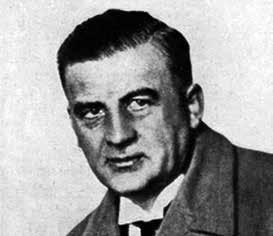
Under his real name, he published art criticism, reflections on aesthetic education and aesthetic studies, and he dealt with folk literature and folklore. His best-known works include the short story collections Večery na slamníku (Evenings on a Straw Mattress), Tabatěrka (Snuffbox) and the novel Moudrý Engelbert (EngelberttheWise) In 1929 he was instrumental in publishing the first Czech translation of Adolf Loos’s book Spoken Into the Void, which included the famous essay Ornament and Crime.
24
PERSONALITIES
Jiří Kroha (1893–1974)
Architect, painter, sculptor, designer and representative of the Czech avant-garde. After graduating from high school, he was admitted to study architecture at the Prague Technical University, which he completed in 1918. Seven years later, he was appointed an extraordinary professor of architecture at the Czech Technical University in Brno, in 1930 he became a regular professor, and in 1930–1931 he became dean of the Department of Architecture and Civil Engineering.
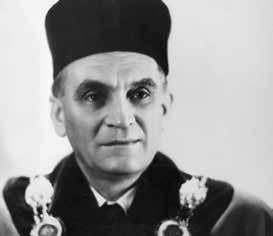
In Brno, he was involved in the construction of the permanent Provincial Exhibition Centre (today’s BVV): in 1928 he became the author of the central exhibition Man and His Lineage at the Exhibition of Contemporary Culture of the Czechoslovak Republic. Between 1932 and 1933, under his leadership at the Faculty of Architecture, the famous Sociological FragmentofHousing was created. In 1934 he was temporarily suspended from his position as a university teacher because of his communist orientation, in 1939 he was arrested by the Gestapo for his social engagement and then imprisoned in concentration camps. After World War II, he returned to BUT to become the dean of the Department of Architecture and Civil Engineering and then became the head of the University as its rector. The Master Studio of the National Artist was set up for him, where he created a number of designs for residential complexes and propaganda exhibition installations. However, the promotion of so-called progressive ideas eventually turned against him. He was forced to move out of the cabinet by the faculty organization of the Communist Party of Czechoslovakia, and in October 1953 he was transferred to the Czech Technical
University in Prague. The studio was dissolved in 1956. Jiří Kroha was a versatile artist, he also worked as a stage designer and designer of utility items and furniture. In 1970, BUT awarded him an honorary doctorate.
Bohuslav Fuchs (1895–1972)
The Czech architect and urban planner studied architecture at the Academy of Fine Arts in Prague under the guidance of Jan Kotěra. After graduating, he first started working as a clerk at the building authority in Brno, and in 1929 he opened his own design office. He is the author of a number of functionalist public buildings, family houses and villas. Together with his wife, he was also active in the field of applied arts. After World War II, he lectured on urban planning at BUT, where he was later appointed a regular professor and served as dean of the Faculty of Architecture and Civil Engineering three times. In the 1950s, he was persecuted by the totalitarian regime and was eventually forced to leave the school for political reasons. His work in the field of modern
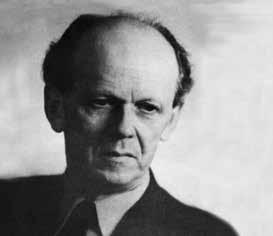
architecture and urbanism is still highly valued today. Bohuslav Fuchs received worldwide recognition and was an honorary foreign correspondent of the Royal Institute of British Architects. He has won several prestigious awards, in 1969 he became a laureate of the Johann Gottfried von Herder Prize, and at home he received the Honour of the Czech Chamber of Architects in 2015.
Otto Wichterle (1913–1998)
The world-famous Czech scientist and inventor studied chemistry at the Czech Technical University in Prague and then enrolled at the Faculty of Medicine of Charles University, where
he passed rigorous exams in biology and medicinal chemistry. From 1940 he was employed at the Bata
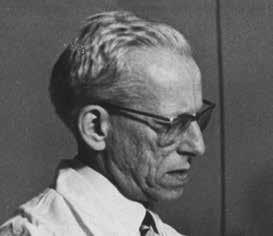
Research Institute in Zlín, and in 1945 he returned to the Prague Technical University, where he habilitated in the field of organic chemistry. A year later, he habilitated in the same field at BUT, where he lectured on Selected Papers from Organic Chemistry at the Department of Chemistry. In 1949, the university submitted a proposal for his appointment as an associate professor of general organic chemistry. At the same time, he was appointed professor of plastics technology at the Prague Technical University, where he began to research the synthesis of cross-linked hydrophilic gels. He wrote textbooks for organic and inorganic chemistry, which were ahead of their time and which he improved until 1958 when he was dismissed from universities for political reasons. He found refuge at the Czechoslovak Academy of Sciences, where he headed the newly established Institute of Macromolecular Chemistry. The first contact lenses that did not irritate the eyes were cast with the help of a children’s building kit. After 1968, he was deprived of all leading posts due to his civic attitudes. Wichterle was a member of international societies, the holder of several foreign awards and an honorary doctorate from foreign universities. He is the author of more than two hundred professional publications and more than 150 inventions and patents. From 1990 to 1992 he was the chairman of the Czechoslovak Academy of Sciences. Since 1993, one of the asteroids in the Solar System has borne his name.
25
PERSONALITIES
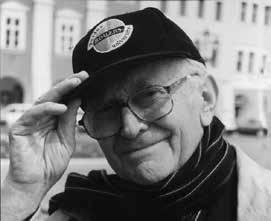
Jan Rajlich Sr. (1920–2016)
Painter, graphic artist, designer, scenographer and publicist, he graduated from the Bata School of Art in Zlín. At first, he worked as a landscape painter, but later he began to devote himself fully to graphic design, in which he achieved world fame. He was one of the pioneers of orientation graphics. He unified visual style in Czechoslovakia, designing around three hundred posters. Ludvík Kundera dedicated the poem Chvála plakátu (Praise of the Poster) to him. Rajlich has to his credit 150 typographic designs of publications, trade fair and exhibition graphics, information systems and hundreds of printed materials, symbols and marks. He also participated in the development of art protis technology combining the art of painting with the technology of nonwovens. In the 1960s, he founded a multidisciplinary art association called the Q Association. In 1963 he initiated the establishment of the international exhibitions Biennial of Applied Graphics Brno and became the chairman of its organizing committee, which he held until 1992. The Brno Biennial was the first exhibition of its kind in the world and Rajlich literally put Brno on the map of the world from behind the Iron Curtain. In the 1980s, he lectured on graphic design and applied semiotics in postgraduate courses at BUT. In 1992, he was one of the founders of the Faculty of Fine Arts, where he subsequently became the first head of the Visual Communications Design Studio, later the Studio of Graphic Design.
Armin Delong (1925–2017)
The world-famous physicist and founder of electron microscopy began studying at the then Dr. Edvard Beneš Czech Technical University after World War II and later worked there as a research assistant and assistant to Professor Aleš Bláha. His work was
closely associated with the Institute of Theoretical and Experimental Electrical Engineering of the Faculty of Electrical Engineering of BUT, where he and his colleagues put into operation the very first electron microscope in the former Czechoslovakia. In 1958, he was awarded a gold medal for his prototype of the BS242 microscope at EXPO 58 in Brussels. From 1961 to 1990 he held the position of Director of the Institute of Scientific Instruments at the Czechoslovak Academy of Sciences, and from 1967 to 1971 he worked as an external Head of the Department of Solid State Physics at the Faculty of Science of today’s Masaryk University.
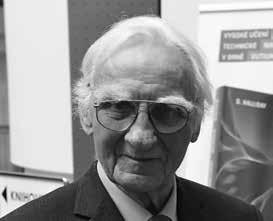
After the Velvet Revolution, Delong became Deputy Prime Minister of the Czech and Slovak Federal Republic for Scientific and Technological Development. In 2005 he received the Czech Head Award, and ten years later he was awarded the Medal of Merit for his lifelong work. In 2014, he received an honorary doctorate from BUT.
Sir Frank Lampl (1926–2011)
The Czech and English manager was born as the son of a Moravian landowner. During the German occupation, he was imprisoned in concentration camps. After the war, he began studying at the University of Agriculture in Brno but was expelled from his studies after the Communist coup in 1948 due to his bourgeois origin. In the 1950s he was sent to forced labour in the uranium mines in Jáchymov as a political prisoner. After his release, he graduated from an evening technical school and became the director of the Opava plant of Building Constructions Ostrava. After the Soviet occupation in 1968, he emigrated to Great Britain, where he worked his way up to the post of CEO and Chairman of the
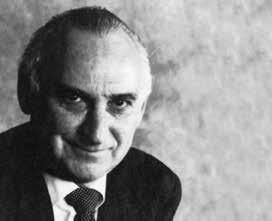
Board of Directors of one of the largest construction companies in the world, Bovis Construction Group. In 1990, Britain’s Queen Elizabeth II awarded him the Order of Knight and the title of Sir for his service to British industry. King Charles III (then Prince Charles) and Václav Havel appointed him chairman of the Prague Heritage Fund, which aimed to reconstruct and restore the gardens of Prague Castle, St. Anne’s Church and the statues on Charles Bridge. In the 1990s, he was at the birth of the Brno Technology Park. In 1993, BUT awarded him an honorary doctorate in the field of economics and management of the construction industry.
Vladimír Preclík (1929–2008)
Originally a trained woodcarver, then a sculptor, painter, writer and long-time Chairman of the Mánes Association of Fine Artists, he graduated from the Academy of Arts, Architecture and Design in Prague. He was the only Czech artist invited to participate in the international exhibition of artists of the 20th century at EXPO 67 in Montreal. His favourite material was wood, but he also devoted himself to stone. One of Preclík’s most important activities for Brno is his work at the Faculty of Architecture of the Brno University of Technology, where he worked as a Professor and Head of the Department of Fine Arts. In 1992, together with Ivan Ruller, he co-founded the Faculty of Fine Arts of the Brno
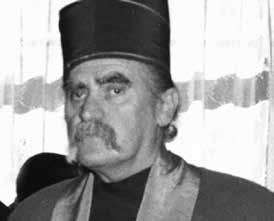
26
PERSONALITIES
University of Technology, which he also led as its first dean from 1993 to 1997. Vladimír Preclík was also known for his literary activities; his intense friendship with Miroslav Horníček and Ilja Hurník materialized in their literary collaboration on the book Trojhlas (TripleVoice,1986). Preclík organized International Sculpture Symposia in Hořice, Deštné and Orlík. His wellknown works include the cycle of portraits Czech Avant-Garde. In 1998 he was awarded the Brno City Prize for his lifelong work in the field of fine arts and for his significant contribution to Brno higher education.
Otakar Diblík (1929–1999)
The legendary designer, who significantly influenced the appearance of Czech means of transport, began studying architecture at the Brno University of Technology in 1948. He developed his talent under the leadership of Bohuslav Fuchs, Antonín Kurial, Bedřich Rozehnal, and especially Vincenc Makovský. In 1956, he began working at Karosa in Vysoké Mýto on shaping the bodies of RTO buses. Two years later, he created a luxurious and highly successful version of this series for the EXPO 58 exhibition in Brussels; his design of the Dingo caravan is also unforgettable. He also collaborated with Tatra Kopřivnice, designed the body of the 230 electric locomotive with laminate fronts for the Škoda Plzeň company, and shaped the body of the Zetor Crystal tractor for Zetor. He decorated the Janáček Theatre in Brno, which was opened to the public in 1965, with artistically enriched fittings, railings and handles made of bronze; he also participated in the development of printing machines for Adamovské strojírny. In 1968 he left Czechoslovakia and accepted a position at the Milanese company Bonetto, where he became Chief Designer in 1983. He returned to Czechoslovakia
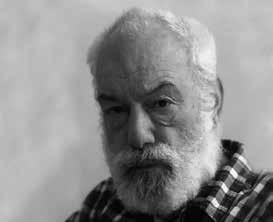
seven years later to become the head of the design studio at the Academy of Arts, Architecture and Design in Prague. In 2022, he was inducted into the Hall of Fame of the Czech Grand Design Awards.
Radek Pilař (1931–1993)
Painter, graphic artist and illustrator, he studied at the Academy of Fine Arts in Prague under Professor Vlastimil Rada. After a trip abroad to Paris in 1963, he began to create the first pop-art-influenced film experiments and joined the State Children’s Book Publishing House as an illustrator. In 1965, his legendary jingle of Večerníček (Czech Bedtime Stories) was first performed, and a year later he collaborated with Václav Čtvrtek on the children’s cartoon series ORumcajsovi. In 1985, he was one of
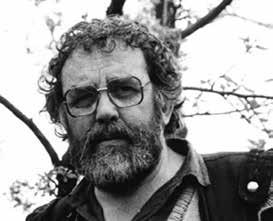
the founders of the Department of Animation at the Film and TV School of the Academy of Performing Arts in Prague, and five years later he established the field of video and intermedia forms. At the invitation of the then Dean of the Faculty of Fine Arts of BUT, Vladimír Preclík, he founded and in the academic year 1992/1993 also headed, the Studio of Fine Electronic and Multimedia Animation, the predecessor of today’s Video Studio. He received recognition for his artistic activities not only in Czechoslovakia at the time, but also in Mexico. He is the recipient of the Hans Christian Andersen Prize, which is considered the most prestigious international award for authors working in the field of literature for children and young adults.
Růžena Žertová (1932–2019)
Although the architect and designer tended to study arts and crafts from a young age, she was only allowed to study architecture at the Faculty of Civil Engineering of the Czech
Technical University in Prague, from where, due to political pressure, she was forced to transfer to the Faculty of Architecture and Civil Engineering of BUT in 1952. The studies and experience gained in the studio of Bedřich Rozehnal reconciled her to architecture to a greater extent.
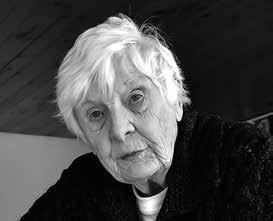
After graduating in 1957, she refused to join a construction office in Ostrava, and after several months without a job, she was hired by Zdeněk Řihák at Potravinoprojekt in Brno, from where, following the split of the company, she moved to the State Design Institute in Brno. Here, between 1960 and 1983, she created her most important works – projects of large department stores, in which she was able to combine artistic intuition and a feeling for material with the ability to rationally design operations. Her best-known projects include the Prior department store in Pardubice, which has made a lasting mark on the history of architecture for its unique shape and material design, the Labe department store in Ústí nad Labem and the department store in Košice, which served as a model for similar buildings in socialist Czechoslovakia. Her study of the Prior department store in Jihlava also represented an extraordinary solution. Later, she focused mainly on the creation of interiors, original lamps, jewellery and clothing accessories, and she also designed residential buildings. In 2009 she was awarded the Gold Medal of BUT, and in 2013 she received the Brno City Award. Five years later, she received the Ministry of Culture Award for long-term artistic merits in architecture, and in the same year, she was awarded the Josip Plečnik Award.
27
PERSONALITIES
HISTORY OF WOMEN’S STUDIES AT BUT
It has been 105 years since women could be enrolled as regular students at the Czech Technical University in Brno.
Although it has been over one hundred years since women could study as equals at the Czech Technical University in Brno, we could meet women in the role of hospitans, albeit in very limited numbers, from the very foundation of the school. Already in the first year of the existence of the Technical University in Brno, we have evidence that Eliška Kozlová (born 1866) and Ludmila Šebestová (born 1872) enrolled in the drawing course with Hanuš Schwaiger. Both ladies were teachers by profession and wanted to attend one subject
as extraordinary students, but they were not permitted to do so by the Ministry, so there is a note next to their names that they can only attend lectures as “guests”. The designation of guest did not entitle them to take an exam in the course, or at least to obtain a certificate of attendance at the lectures in question. With the teacher’s consent, they could only attend classes.
Eliška Kozlová comments on this in her memoir Jak jsme ve Vesně žili a pracovali (How We Lived and Worked in Vesna): “After the establishment of the Czech Technical University,
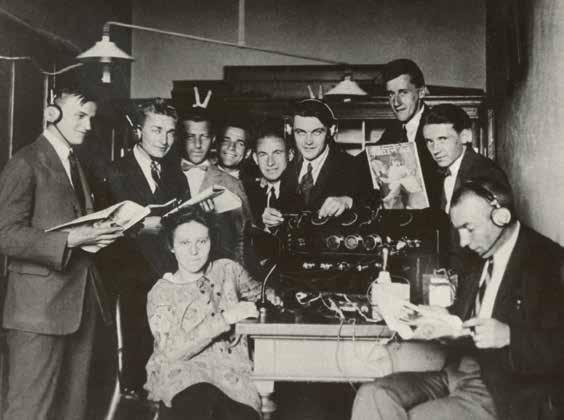
two teachers were allowed to attend drawing lessons with Professor Schwaiger as guests (! ); the first students welcomed them collegially, but already in the second year, the first-year students were preparing toexpelthe‘femaleintruders’. However, this did not happen, and ProfessorSchwaiger’scoursewas joined by more ladies”.
Prior to 1918, women were allowed to attend a non-technical course in State Accounting for five hours a week, which was taught here. From the academic year 1909/1910 onwards, several female students enrolled in it with the status of extraordinary students. The course was taught at the Czech Technical University in Brno until the end of the 1920s, and the last time it was included was in the school year 1929/1930. In total, approximately 160 women enrolled in this course. Some women also added courses of languages and shorthand writing, for example, but there were not many of them. During the war years, we gradually spot women who, as extraordinary students, studied strictly technical subjects.
A major turning point was the school year 1918/1919, when women could begin to enrol as regular students. The first to be registered were: Marie Haičmanová, Miloslava JavůrkováDonátová, Marie Jůvová, Miroslava
28
ALŽBĚTA BLATNÁ / PHOTO BUT ARCHIVES AND ARCHIVE OF TOMÁŠ NEBESKÝ, GRANDSON OF SLÁVKA VULETIČ-DONÁTOVÁ
WOMEN AT BUT
WOMEN AT BUT
Electrical engineering students of Czech Technical University in Brno
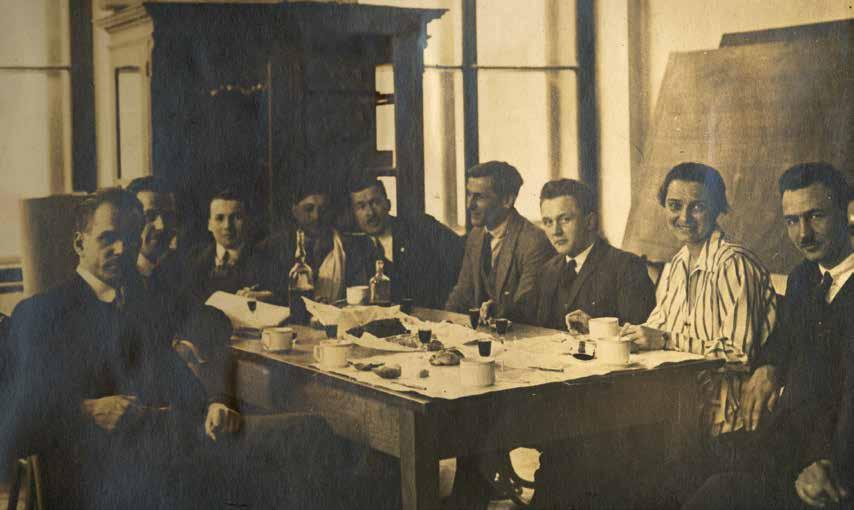
Radićová, Karla Sumcová, Štěpánka Utíkalová and Anežka Zichová. The latter two had already begun their university studies before 1918 as extraordinary students. With the exception of Miroslava Radić, all of the above-mentioned ladies managed to complete their studies and became engineers.
Miroslava Radić was the daughter of the well-known Croatian politician Stjepan Radić, who was assassinated in 1928. In 1921 she married Augustin Košutić, a future Croatian politician who was studying at the Czech Technical University in Brno and held the position of assistant. In December 1921, Augustin Košutić completed his studies and then returned to his homeland, where he embarked on a political career. It can be assumed that his young wife followed him, so her studies in chemical engineering remained unfinished. However, her case illustrates a fairly common phenomenon. When women studying at the Technical University in Brno got married, they typically married men from among their colleagues and classmates. This also applies to Miloslava Javůrková-Donátová (married Vuletič-Donátová for the second time) or Karla Sumcová
(married Zikánová), the daughter of Professor Sumec. Anežka Zichová (née Václavíková) also married her colleague from the technical school, with whom she then ran a driving school. Unfortunately, details of the fates of many of our female students often remain unknown to us.
In 1923, the first female engineering degrees were granted at the Czech Technical University in
Brno – three in the Department of Chemical Engineering and two in the Department of Electrical Engineering. On May 8, 1923, Marie Haičmanová and Věra Hanáková passed the second state examination at the Department of Chemistry. In June, Irena Löwy joined the successful graduates of the chemistry department and began studying chemistry at the German Technical University. In the same year, Slávka
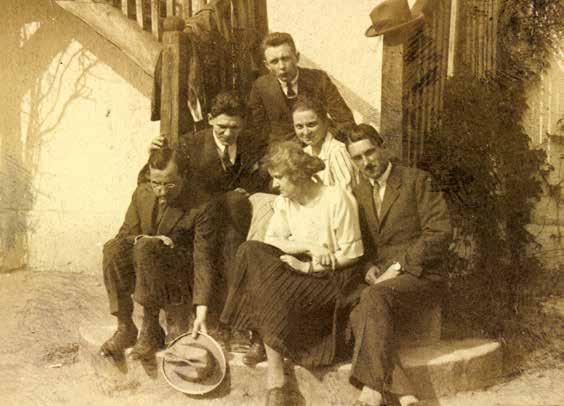
29 WOMEN AT BUT
Dynamic restaurant, snack at colleague Zapletal’s in hydromechanics
Slávka Vuletič-Donátová (in the middle) and Ludmila Hromádková with colleagues on an excursion
Vuletič-Donátová and Karla Sumcová, who married soon after her final exams and devoted herself to family life, completed their studies in electrical engineering. We have the most information about Slávka Vuletič-Donátová, whose life is dealt with in a separate article.
Most often, women enrolled to study chemistry. On the other hand, mechanical engineering was the least frequented, where we have the first and, until World War II, the only female graduate documented in 1938 in the person of Božena Hejlová. By World War II, a total of 30 women had obtained an engineer’s degree at the Czech Technical University in Brno, which is a really small number compared to the number of male graduates, which was more than a hundred times higher. Otherwise, however, women who studied copied the general trends that can be traced in the studies of their colleagues: among the students there were a significant number of students of nationalities other than Czech or Czechoslovak; after 1921, it was mainly Russian emigration. The same is true of religious affiliation, which was also varied. Another fact is that the study rarely lasted the standard time in which it could be managed, often students applied for the second state exam only after a longer period of time after attending lectures and passing the prescribed

partial exams. And of course, not all of those who applied to study also successfully graduated from the University. Women typically applied to the Technical University together with their brothers, or they were the daughters of University professors.
The first graduate of her doctoral studies at the Czech Technical University in Brno was Antonína Rudavská (married Medvedeva) in 1928. In the 1930s, she was successfully followed by Marie Wasgestianová, Olga Laubová (née Sklenářová) and Theodora Stojanová (née Ebrová); All of them studied chemistry. Two graduates, Marie
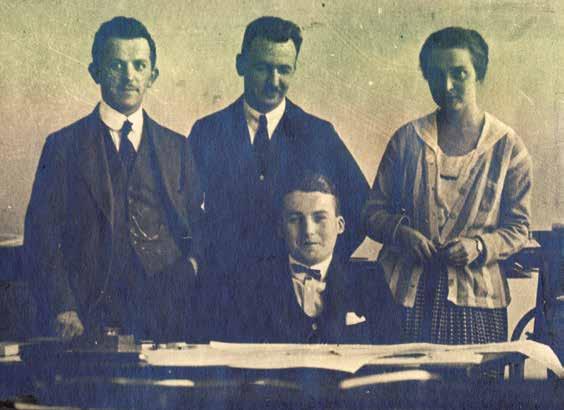
Jůvová and Libuše Hrubešová (née Kostelková), even worked as assistants at the Technical University for a long time.
SLÁVKA VULETIČ-DONÁTOVÁ WAS A DISTINCTLY EMANCIPATED WOMAN
In 1923, Miloslava Javůrková-Donátová, who studied electrical engineering, was among the first female graduates of the Czech Technical University in Brno.
She was the daughter of Josef Donát, the founder and owner of the famous company Bartelmus, Donát a spol. Josef Donát was an important patron of the University and an excellent engineer, so at first he often worked as a member of the examination committee at the Czech Technical University in Brno during state exams. But let’s focus our attention on his daughter Slávka Vuletič-Donátová, as she is most often mentioned. She was a remarkable and emancipated woman for her time. She was born on February 20, 1890, in Brno to Josef Donát and his wife Růžena, so she grew up in a well-to-do family. In 1912 she married lawyer Václav Karel Javůrek, and in 1914 her daughter Miloslava was born. Her marriage was not a happy one, the couple lived together only for a short time and officially divorced in 1921.
30 WOMEN AT BUT
Architecture students, 1937
Tests for the second state exam, February 1923
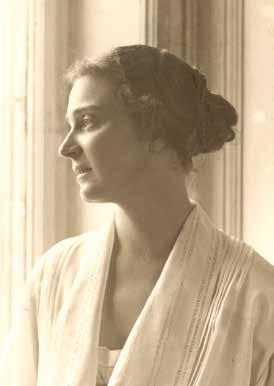
At that time, Slávka was already studying at the Czech Technical University in Brno. According to period photographs, she also participated in school excursions and lived a student life. She was a passionate photographer and later also a filmmaker. She owned a car and took part in social life in Brno. She was the honorary chairwoman of the academic reading association Zora and the honorary chairwoman of the Czechoslovak Red Cross. She met Milan Vuletič, who studied civil engineering at the Czech Technical University in Brno, but was known mainly for his involvement in the Association of Engineering Students, of which he was also the chairman for some time. It was mainly thanks to him that the Academic Canteen was established, which provided food for the poorest students during the war and post-war period. A year after completing her studies, Slávka married Milan Vuletič, but unfortunately this marriage did not last long either as he soon succumbed to tuberculosis.
At the beginning of the 1930s, Slávka lived on Wurmova Street in a stylish home designed by Karel Sebastian Jan Kepka. She also participated in public life. For example, she made friends with the female racer Eliška Junková and during races at the Masaryk Circuit she photographed and filmed events on and around the track. After the merger of Bartelmus, Donát a spol. with Škoda Works,
she was a member of the General Council, so she did not stray from her field of study even at that time. She died on February 23, 1950, shortly after her sixtieth birthday. The fact that her house on Wurmova Street was confiscated shortly before her death as a result of the developments following the communist coup certainly did not help her health.
ANTONIE ADÁMKOVÁ STUDIED IN ORDER TO BE ABLE TO BECOME INDEPENDENT
As a gift for her hundredth birthday, Antonie Adámková (1900), who was one of the first women to study at the Czech Technical University in Brno, received an honorary engineering degree by BUT.
At the beginning of the 1920s, as Antonie Jebavá, she completed all her studies at the Electrical Engineering Department of the Faculty of Mechanical Engineering, but she did not receive her engineering degree together with the commemorative medal of the Brno University of Technology until 2000 at the age of one hundred. “The reason why I went to study engineering was to be independent. At first,Iwenttoagirls’lyceum,which was not focused on technology or humanities, so I had to complete my educationbeforeuniversity,” the hundred-year-old graduate recalled
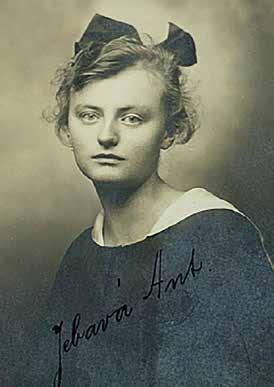
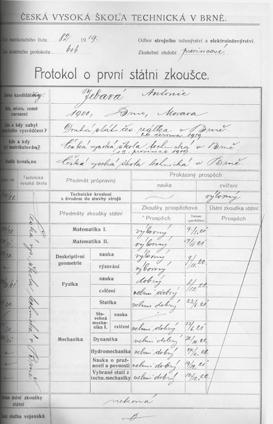
of her studies. So she first went to a graduate course for girls in Chrudim, then she completed her secondary education at a secondary school on Křenová Street in Brno and only then could she enrol at the Brno University of Technology.
She chose the field of electrical engineering because it had a great future at the time and she expected good career prospects from it. “Atthefaculty,Ifeltcomfortable among men. They were never rude to me, as men sometimes are, on the contrary, they behaved in a very gentlemanly manner. I had verygoodfriendsamongthem,” Antonie Adámková said in 2000. She enjoyed descriptives and statics in technology, and she was especially fond of mathematics. She bought and read professional books in this field even later, when she was already a housewife. Her interest in technology and everything new is also evidenced by the fact that she was probably the first woman in Brno to own a driving license and in 1923 she was a member of the Czechoslovak Automobile Club for Moravia and Silesia. She got married in 1924 and did not pass her second state exam. However, she was proud of the degree she received almost eighty years after her state exams: “Ipassedmyfirststateexamswith honours and I appreciate the engineer’sdegreeverymuch.”
31 WOMEN AT BUT
Slávka Vuletič-Donátová in 1923
Antonie Jebavá’s state examination report
Antonie Adámková Jebavá
THE PROMOTERS OF BUT’S GOOD NAME
Get acquainted with some of the names of the Brno University of Technology graduates who today represent BUT in important positions at home and abroad.
PETR BRZEZINA
In 1988 he graduated from the Faculty of Mechanical Engineering, but he already worked as a scholarship holder at První brněnská strojírna during his studies. There he later took up the position of a designer and gradually worked his way up to high managerial positions, which he held in Czech and foreign companies such as ABB, Alstom General Electric and OHL ŽS, where he held the position of CEO. His technical education was a great advantage everywhere. In 2018, he received an offer he could not refuse, and he became the President and Chairman of the Board of Directors of Škoda Transportation, the largest transport engineering group in Central and Eastern Europe. In 2021, he was awarded by Forbes magazine as one of the best Czech CEOs of the year. In February 2023, Westinghouse Electric Company named him President of Westinghouse Czech Republic.
JANA DRBOHLAVOVÁ
A 2008 graduate in physical chemistry at the Faculty of Chemistry, she currently works at two workplaces –the Faculty of Electrical Engineering and Communication, and the South Moravian Information Centre. At the Department of Microelectronics FEEC, she is participating in the project to prepare a National Competence Centre for Semiconductors, which is followed by her work at the JIC, where she maps the needs of companies and prepares them for open cooperation in the field
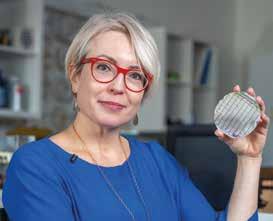
of semiconductor technologies. Her work as a Seconded National Expert on Advanced Materials at the European Commission in 2017–2023 has brought her a wealth of experience in the safety and sustainability of materials and chemicals, as well as building citizens’ trust in nanoparticle-containing technologies, notably through her collaboration with the European Nanomaterials Observatory (EUON). Fifteen years of experience at the Department of Microelectronics has helped her penetrate the field of nanostructured sensors and biosensors, so she keeps up with the latest developments in the EU Chips Act.
LUKÁŠ FLAJŠMAN
In 2010, he began his studies in physical engineering and nanotechnology at the Faculty of Mechanical Engineering, where he was allowed to participate in research from the first year. He began to research the interaction of light with magnetic materials and has stuck with this topic to this day. During his master’s studies, he worked at the world-class research institute Néel in Grenoble, where he
gained valuable experience in the field of nanomagnetism, which he immediately used in his doctoral studies at the newly established scientific workplace CEITEC BUT. With his contribution, a completely new branch of magnonics was established in the Czech Republic, which was engaged in the research of recording magnonic structures using ion beams. He was then offered a scientific position at Aalto University in Finland, where he received his first major grant to study the interaction of magnons and phonons a year later. Currently,
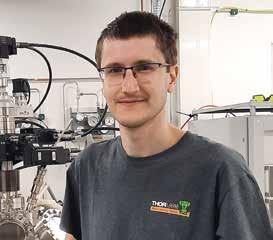
he continues his research in the direction of quantum magnetism and the interaction of magnons with spin quantum memories based on erbium ions. The system should allow for building an efficient converter between microwaves and light, which would be a basic predisposition for a quantum internet infrastructure.
JAN HÜBNER
In 2001 he graduated from the Faculty of Civil Engineering with a
32 ALUMNI
ALUMNI
SYLWIA ŘÍHOŠKOVÁ / PHOTO JAN PROKOPIUS, ARCHIVE OF VUTIUM PRESS, ARCHIVE OF THE MINISTRY OF EDUCATION, YOUTH AND SPORTS, ARCHIVE OF ON SEMICONDUCTOR
degree in structural engineering and enriched his academic education by successfully graduating from the Faculty of Business and Management in 2004. After completing his studies, he joined CTP, where he began his varied journey of work experience in European companies. From 2012 to 2017, he worked as Country Construction Director Poland for HB Reavis and, based on successful projects in Poland, continued his career until 2020 as Country CEO Hungary. He has become one of the leading experts in the field of office and industrial construction in CEE. CTP, which is one of the largest developers of commercial projects in Europe, has repeatedly used his professional experience and is currently using him as Construction Director in the Czech Republic for the development of innovative modern buildings throughout the Czech Republic. One of the most important achievements is the development and construction of the Vlněna office complex on Přízova Street, which is significantly changing the face of the south of Brno and the surroundings of the main train station.
PATRIK CHOVANEC
In 1999, he graduated in industrial management economics at the Faculty of Business and Management and joined BBG Finance as a Senior Portfolio Manager. During the year, he worked his way up to the position of Deputy Director with responsibility for the management of the company and for the successful takeover of part of the company acquired by J&T Securities (Czech Republic) and its integration into the J&T structures. After nine years in various managerial positions, where he gained extensive professional and managerial experience, he became the Director of J&T Bank in Brno. Responsible for the complete setup of the new branch, construction, human resources, processes and cash desk. He is an enthusiastic collector of contemporary art as well as a consultant for investing in art. He is a member of the Scientific Council at the Faculty of Business and Management.
LUKÁŠ KINTR
A 2014 graduate of Managerial Informatics and Information Management at the Faculty of Business and Management, he works
as a computer scientist and manager. Already during his studies, he tried to gain experience in ICT and develop knowledge and skills in the field of cybersecurity. In 2015, he joined the National Cyber Security Centre (NCSC) as a cyber security auditor, which was part of the National Security Authority (NSA) until 2017, and later worked as the head of the control department at the National Cyber and Information Security Agency (NCISA). Since September 2019, he has held the position of Deputy Director of the National Cyber and Information Security Agency (NCISA) for the management of the NCSC, the section responsible for setting up the strategy for ensuring and enforcing cyber security in the Czech Republic, for the activities of the government Computer Emergency Response Team, for negotiations and cooperation with national and international partners, and for conducting cyber security exercises. In July 2022, he was appointed Director of the National Cyber and Information Security Agency (NCISA).
JITKA RESSOVÁ
A graduate of the Faculty of Civil Engineering (1993) and the Faculty of Architecture (1999), she defended her doctoral thesis at the Academy of Arts, Architecture and Design in Prague in 2012 on the rehabilitation of the Bata houses in Zlín, which was also published in the same year in book form under the title Můjbaťovský domek (MyBataHouse). She gained her architectural experience at Ateliér Brno and the Transat architects studio. From 1999 to 2011, she worked at the Department of Design at the Academy of Arts, Architecture and Design in Prague as an assistant and then as the head of the department. In 2002, she was a member of the founding team of the Ellement Design and Architecture Office, which has long focused on the reconstruction
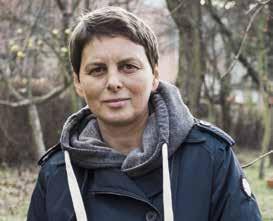
of various types of Bata houses, as well as on the popularization of local architecture and its heritage. In 2013, their revitalization of Gahura Prospect in Zlín was acclaimed, and in 2019 the Ellement office was nominated for the Architect of the Year award. Since 2011, Jitka Ressová has also been a member of the aArchitektura association, which is engaged in popularizing and raising awareness of architecture in Zlín.
JIŘÍ ROSENFELD
In 1974, he graduated in engineering technology at the Faculty of Mechanical Engineering and joined Slovácké strojírny as a technical and organizational development worker for the use of NC technologies and modern tools. Over the course of 22 years, he has gradually worked his way up to the position of CEO, where he currently serves as Chairman of the Board of Directors. During his career, he has put into practice modern technological processes of machining, welding and surface treatment. He is behind the successful construction of the training centre, he is credited with the establishment of the Accredited Laboratory for the Measurement of Basic Engineering and Electrical Quantities and the construction and commissioning of the Science and Technology Park focused on new engineering technologies. He proved his managerial experience in the field of acquisition activities, such as the integration of NH Zábřeh, MEP Postřelmov, MEP Slévárna, MEP Galvanovna, TOS Čelákovice and Krušnohorské strojírny into the structure of Slovácké strojírny. This resulted in a strong engineering complex with a diversified production base. He regularly lectures at universities. He is the holder of several awards, such as the Order of the Laurel 2012 awarded by the Czech Chamber of Commerce, the Personality of the Zlín Region 2014, and in 2016 he was a finalist in the EY Entrepreneur of the Year competition.
BRONISLAV SLOVÁK
In 1999 he graduated from the Faculty of Chemistry in the field of food chemistry and biotechnology. He completed his doctoral studies in business management and economics in 2001 at the Faculty of Business and Management and in 2003 in the
33
ALUMNI
field of environmental chemistry at the Faculty of Chemistry. For more than 22 years, he has been working at Hartmann-Rico, which is part of the Hartmann Group and is a leading manufacturer and supplier of medical devices to the hospital and outpatient sector. He has held various positions there, for the last 15 years he has been working as the director of the plant in Chvalkovice and is a qualified person for the distribution of pharmaceuticals. During his tenure, the plant was substantially rebuilt, and among the important projects, it is worth mentioning the transfer of the production of procedure trays from European plants in Belgium and France, associated with the expansion of production facilities and the provision of sterile packaging technology as well as the introduction of the production of disposable surgical instruments, including the development of the technology and processes associated with their production. He managed to increase production to 21 million tools per year, so that today the plant is one of the largest suppliers of this range in Europe.
JIŘÍ STRÁSKÝ
Since 1969, when he graduated from the Faculty of Civil Engineering, he has been involved in the design of engineering structures. Since 1991 he has been an associate professor in the field of Concrete Constructions, two years later he became a professor at the Institute of Concrete and Masonry Structures FAST, where he has been teaching since 1994. He received the title of Doctor of Science from the

Academy of Sciences of the Czech Republic in 2006. He is the author of a number of professional articles and books. His main research topic
is the development and design of suspension and suspension systems and structures made of prestressed strip or the development of hybrid structural systems made of steel and concrete. He is the author of more than 150 bridge structures implemented all over the world. For more than 30 years, he has been working in the design of bridges and special structures for engineering and building construction. He designs road and motorway flyovers, railway viaducts, city bridges and pedestrian bridges from a variety of materials. He has received many awards for his work, such as the Fritz-Schumacher Prize 1991, the CTU Award 2003, the Prix Albert Caquot from the French Association for Civil Engineering 2013, the Building of the Year 2022 and the Ministry of Education, Youth and Sports Medal in 2023.
ADÉLA SVOBODOVÁ
A graduate of the Faculty of Fine Arts in 2005, she is now an internationally acclaimed graphic designer known for her ability to work complex and disparate topics into visually stunning publications. She has received a number of awards for her work, such as The Most Beautiful Swiss Books 2010 for her publication Atlas of Transformation or the main prize in the Czech Grand Design 2021 competition in the Graphic Designer of the Year category for the graphic design of the books Exhibition as a Medium –Czech Art 1957–1999, Street Theatre and the catalogue Fashion in Blue to an exhibition about the tradition of Czech and Japanese textiles dyed with indigo and the future of blueprint. On the latter book, Adéla Svobodová collaborated with Tereza Hejmová, who works at the Faculty of Fine Arts in the Studio of Graphic Design 2. Adéla Svobodová is a member of the Ládví group, which focuses on artistic activities in public space on the border between art and public benefit activities. Together with French designer Pauline Kerleroux, she founded the Pauline & Adela studio.
MAREK JAN ŠTĚPÁN
In 1991 he graduated from the Faculty of Architecture with a degree in Neoplasm in Historical Environment and Theory of Architecture. In 1997 he founded Atelier Štěpán with a focus on architecture, public space
and design. In his projects, he develops the archetypal concept of architecture, focusing on projects of sacral buildings, new buildings and reconstructions, of which he has over twenty to his credit. He also designs other civic and residential buildings, and is the author of the concept of low-cost mobile free houses. He is the winner of several important awards, such as the Club for Old Prague Award 2005, Interior of the Year 2017, Grand Prix of Architects 2020 and Building of the Year 2021. In 2017, the church of St. Wenceslas in Sazovice, which received the Patria Nostra award, was selected among the ten best buildings in the world.
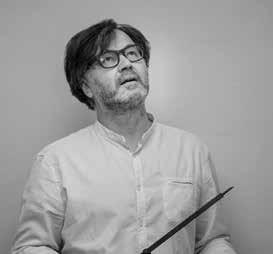
He is a member of the Czech Chamber of Architects, the Artistic and Liturgical Commission of the Ostrava-Opava Bishopric and the Board of Trustees of the St. Vitus Organ Endowment Fund. From 2006 to 2012, he worked as an advisor to the Head of the Office of the President of the Czech Republic in matters of architecture.
EVA ŠŤASTNÁ
Eight years ago, the research centre attracted the graduate of Advanced Materials at CEITEC BUT not only for its reputation, but above all for its modern laboratory equipment, opportunities for international cooperation and interconnection with industry. Soon after starting her studies, it was clear that for successful research she needed the facilities of the CEITEC Nano laboratories, to which she easily gained access to as a doctoral student. Her encounter with an electron microscope proved to be decisive for her future career. Towards the end of her studies, she applied for the position of Application Specialist in the Development Department of
34 ALUMNI
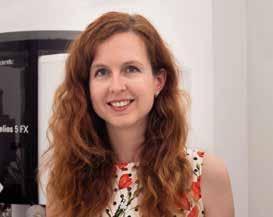
the Electron Microscopes Division at Thermo Fisher Scientific, where most of her work consisted of tasks related to the development and advancement of microscopes. After a year, she was given the opportunity to take up the position of Application Team Manager for the semiconductor industry. Today, she leads a team of eight people involved in the development of highend electron microscopes that can be used in research, development and industry.
JIŘÍ TOBOLA
In 2007, he graduated from the Faculty of Information Technology and then worked as a researcher at CESNET, where he participated in a number of European research projects. In 2007, he was one of the founders of Flowmon Networks, which he first developed as CTO, then took responsibility for its business development and then led it as CEO for three years. During his tenure, the garage start-up has grown into an international company with operations in 45 countries around the world. Flowmon Networks, which helps companies manage and secure their network infrastructure through modern technology for monitoring and analyzing the behaviour of computer networks based on data flows, was acquired in 2020 by Kemp Technologies, an American
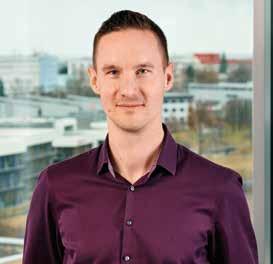
technology company. He is currently putting his experience to good use at the South Moravian Information Centre, where he works as a mentor, consultant and guide and is a member of the Board of Directors of start-ups/ scale-ups. He is a member of the FIT Industrial Council.
RADEK VÁCLAVÍK
After graduating from the Faculty of Electrical Engineering and Communication in 1994, he joined the Academy of Sciences of the Czech Republic, where he developed hardware for nuclear tomography. After a brief stint as a product engineer at Motorola, he landed at onsemi, a globally recognized and successful multinational company that focuses on automotive and industrial applications and accelerates current changes in megatrends such as car electrification and safety, sustainable energy networks, industrial automation, 5G and cloud infrastructure. Over the course of 24 years, he has worked his way up from the position of project leader to the position of director of new product development for the Central European region.
MICHAL ZÁVIŠEK
In 2002 he graduated in biomedical engineering from the Faculty of Electrical Engineering and Communication. He has been with Honeywell for more than 18 years, where he helped win two major Clean Aviation projects that have the ambition to change the future of aviation. Over the years, he has worked his way up from the position of Systems Engineer to Vice President and General Manager of Honeywell Technology Solutions EMEA and leads numerous teams of engineers in the Czech Republic, Poland, France and Switzerland. He is responsible for the implementation of research, development and application of programs for regional and global customers of several product lines in the fields of aviation, safety and productivity, including cockpits, flight controls, navigation, data lines, space technology, healthcare, warehouse automation, personal protective equipment, etc. Under his leadership, the Technology Center holds more than a hundred patents, including projects for European space missions. He himself holds two patents. He also devotes
himself to aviation in his free time and is a holder of a glider pilot’s license.
BARBORA ZENTKOVÁ A JULIA GRYBOŚ
At the Faculty of Fine Arts, they completed their master’s (2014) and then doctoral studies (2023). From 2013 to 2017, in parallel with their own artistic practice, they jointly ran the TVAR Gallery in Brno, where they organized more than 50 events, concerts, screenings, exhibitions and performances. Today, as an internationally acclaimed artistic duo, they live in Berlin. They focus on creating site-specific installations, multi-layered environments, and performative sound actions. As an artistic duo, they won the Oskár Čepan Award for Young Artists in 2016 and have participated in a number of artistic residency programs, such as the Contextile Biennale in Guimarães, Air Futura in Prague, the Zentrum für Kunst und Urbanistik in Berlin, the Museumsquartier in Vienna, the Residency Unlimited in New York, and the PROGR Residency.
KATEŘINA ŽMOLÍKOVÁ
In 2016, she graduated from the Faculty of Information Technology in the field of mathematical methods, and in 2022 she completed her doctoral studies there. Her main expertise is in the field of machine learning for speech enhancement and separation with knowledge of other tasks such as speech recognition or speaker recognition and diarizing. As a student, she collected many awards. In 2016, it was the Zdena Rábová Award, which is awarded to students for outstanding results that increase the prestige of the school, and in the same year she was awarded within the Brno Ph.D. Talent Program for her work developing algorithms that automatically extract the content of human utterances. In 2020, she was awarded the J. Fourier Prize for her work in the field of speech separation for doctoral students for successful research work in the field of computer science. In 2021, she was successful in the international Clarity Challenge, which focused on developing more user-friendly hearing aids for people with hearing impairments. Since October 2023, she has been working as an AI Research Scientist at Meta in London.
35
ALUMNI
SCHEDULE OF EVENTS
JANUARY 19, 2024
SCIENTIFIC ADVISORY BOARD
The celebrations of the 125th anniversary of the founding of BUT were launched by a meeting of its Scientific Council. Its regular program was supplemented by a presentation of the Year of Celebrations.
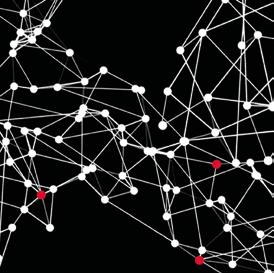
APRIL 9–10, 2024
NATIONAL TRANSFER CONFERENCE 2024
The eleventh year of the national transfer conference, which is to focus mainly on the impact of legislative changes on the transfer workplaces of research organizations. The Conference is held under the auspices of the Transfera.cz association.
APRIL 23–24, 2024
CESAER TASK FORCE
Meeting of the Task Force Learning & Teaching of the prestigious European research network of technical universities CESAER. The event will be attended by important representatives of European technical universities and participants of the European Higher Education Area who are shaping the future of technical education. At the same time, the meeting is a key preparatory event for the upcoming
autumn International Conference on Technical Education.
MAY 11, 2024
BRNO MAJÁLES
This student festival will offer not only a varied musical program but also a traditional competition for the King and Queen of Majáles. The BUT presentation will take place within the University zone and will be complemented by the rich music program with demonstrations of student activities and outputs of student creative activities.
MAY 22–25, 2024
EUL i ST GENERAL ASSEMBLY
The General Assembly of the European University EULiST consists of ten European universities with a predominantly technical focus. Membership in EULiST allows universities to more easily develop cooperation in science and research while promoting student and staff mobility. This gathering is an opportunity to share information, strengthen connectivity in the academic environment and find ways to promote technical education among the individual universities.
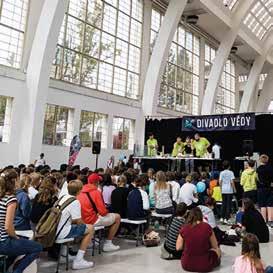
SEPTEMBER 6–8, 2024
FESTIVAL OF SCIENCE AND TECHNOLOGY
The Science Festival is a traditional annual event that aims to bring science closer to the general public and show it as magical, funny and surprising. Interactive demonstrations are prepared for visitors to help them grasp the beauty of scientific research.

SEPTEMBER 16–20, 2024
SPORTS WEEK AT BUT
The first week of the new academic year will be packed with sports, tournaments, races, competitions, and especially entertainment prepared by the Sports Activities Centre. All BUT students and employees are encouraged to participate.
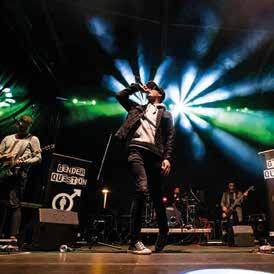
SEPTEMBER 18, 2024
HUDBA Z FEKTU (MUSIC FROM FEEC)
This music festival is inextricably linked to the beginning of the
36
CALENDARIUM CALENDARIUM
winter semester. Mainly student bands will take turns on the stage, but you can also look forward to some well-known names. This year, the event will also commemorate the 65th anniversary of the founding of the Faculty of Electrical Engineering and Communication.
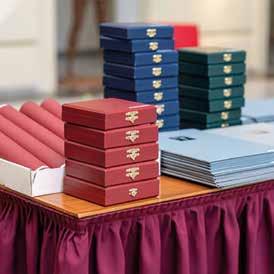
SEPTEMBER 19, 2024
ACADEMIC ASSEMBLY CEREMONY
The ceremonial academic assembly is a traditional ceremony that includes the presentation of the BUT Rector’s award. These are gold, silver and commemorative medals, Rector’s Awards for students and also prizes for the best teachers according to student evaluations.
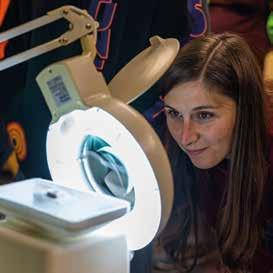
SEPTEMBER 27, 2024 RESEARCHERS’ NIGHT
Every year, the most famous popularization event intended for the general public attracts crowds of interested people to places they usually cannot reach. BUT will open its laboratories, lecture halls
CALENDARIUM
and other spaces and offer a rich program that even the smallest ones will enjoy.

OCTOBER 1, 2024 FASTFEST
The beginning of the semester at the Faculty of Civil Engineering is associated with the FASTfest music festival. Entertainment will be provided by student bands and well-known headliners.
OCTOBER 8–11, 2024
INTERNATIONAL ENGINEERING FAIR
BUT will also be present at the 65th edition of the most important industrial fair in Central Europe, where it regularly wins Gold Medals. Also this year, visitors can look forward to the stand of the Brno University of Technology where they can get acquainted with the latest research results of BUT scientists.
OCTOBER 21–22, 2024
INTERNATIONAL CONFERENCE ON TECHNICAL EDUCATION
This international conference is a follow-up to the activities and events carried out at BUT at the national and international level aimed at supporting technical education to increase the competitiveness of the Czech Republic and the European Union.
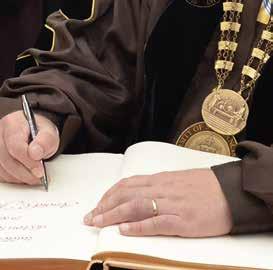
NOVEMBER 29, 2024
CEREMONIAL SCIENTIFIC COUNCIL
On the occasion of the ceremonial meeting of the BUT Scientific Board, honorary doctorates will be awarded.
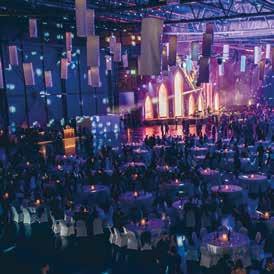
DECEMBER 6, 2024 BUT BALL
The celebrations of the 125th anniversary will conclude with the BUT Ball, which is a unique event for students, employees, graduates, partners and friends of BUT. Over the years, the gala evening, sought after not only by technicians, has become the largest ball in the Czech Republic.
CALENDARIUM

